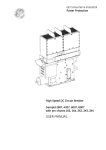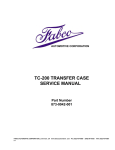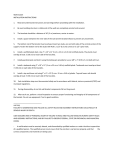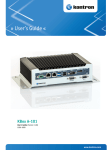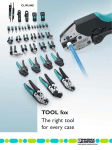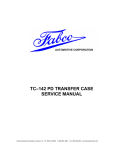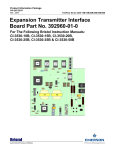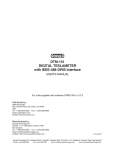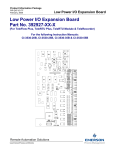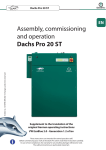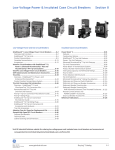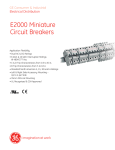Download GE Consumer & Industrial
Transcript
GE Consumer & Industrial Power Protection High Speed DC Circuit Breaker Gerapid 2607, 4207, 6007, 8007 with arc chutes 1X2, 1X4, 2X2, 2X3, 2X4 USER MANUAL 2012-11-21 S47183R01E06 Design and specifications are subject to change without notice 1 2 Design and specifications are subject to change without notice S47183R01E06 2012-11-21 INDEX 1. WARNINGS .............................................................................................. 4 2. GENERAL USAGE CONDITIONS ..................................................... 4 2.1 Transportation and storing ....................................................... 4 2.2 Installation .......................................................................................... 5 2.2.1 Operational environment................................................... 5 2.2.2 Installation and interfaces ................................................. 5 2.3 Usage .................................................................................................... 5 2.3.1 Supply and load ...................................................................... 5 2.3.2 Adjusting the over current release................................ 5 3. TECHNICAL INFORMATION.............................................................. 6 3.1 Introduction ....................................................................................... 6 3.2 Components and accessories ................................................. 6 3.2.1 Contact system ....................................................................... 6 3.2.2 Arc chute (Code 2) .................................................................. 6 3.2.3 Mechanism ................................................................................ 7 3.2.4 Over current release (Code 7) ......................................... 7 3.2.5 ED impulse coil release (Code 12) .................................. 8 3.2.6 Auxiliary tripping devices (Code 11) .............................. 8 3.2.7 Forced tripping release (Code 13) .................................. 8 3.2.8 Lever for manual operating (Code 16) ....................... 9 3.2.9 Auxiliary switch (Code 9) .................................................. 10 3.2.10 Indicators .............................................................................. 10 3.2.11 Solenoid closing drive (Code 3) .................................. 10 3.2.12 Current measurement system (Code 6) ................ 11 3.2.13 Electronic control system ............................................. 11 3.3 Technical data tables ................................................................ 13 5. DIMENSIONS & SAFETY DISTANCES ........................................ 28 5.1 Safety distances. .......................................................................... 29 5.2 Outlined dimensions .................................................................. 30 5.2.1 Gerapid 2607,4207, 6007 with arc chute 1x_...... 30 5.2.2 Gerapid 2607, 4207, 6007with arc chute 2x_...... 31 5.2.3 Gerapid 8007 with arc chute 1x_ ............................... 32 5.2.4 Gerapid 8007 with arc chute 2x_ ............................... 33 5.2.5 Gerapid 2607, 4207 with H / H terminals............... 34 5.2.6 Gerapid 2607, 4207 with V / V terminals ................ 35 5.2.7 Gerapid 6007 terminals ................................................... 36 5.2.8 Gerapid 8007 terminals ................................................... 37 6. INSPECTIONS AND MAINTENANCE .......................................... 38 6.1 List of inspections ........................................................................ 38 6.1.1 General visual inspection ............................................... 39 6.1.2 General functional inspection ...................................... 39 6.1.3 Inspection of the arc chute ............................................ 39 6.1.4 Inspection of the contact system ............................... 40 6.1.5 Inspection of contacts’ tilt and gap .......................... 41 6.1.6 Inspection of the screw connections ....................... 41 6.1.7 Inspection of the mechanical components .......... 41 6.2 List of maintenance works ..................................................... 42 6.2.1 Contact system (after 11/2003)................................... 43 6.2.2. Contact system (before 11/2003). .............................. 44 6.2.3 Layout of control PCB inside control box ............... 46 6.2.4 Replacement of the control boards .......................... 46 6.2.5 Adjusting the auxiliary switch ...................................... 48 6.3 Spare parts lists. ........................................................................... 49 6.3.1 Mechanical spare parts. .................................................. 49 6.3.2 Electrical spare parts. ....................................................... 50 6.3.3 Recommend materials for selected works. .......... 50 4. ELECTRICAL CIRCUITS ..................................................................... 15 4.1 Controls layout .............................................................................. 15 4.2 Terminals wiring system .......................................................... 16 4.3 Electrical diagrams ..................................................................... 17 4.3.1 Wiring code ............................................................................ 17 4.3.2 Controls supply circuit ...................................................... 18 4.3.3 ED coil with external capacity bank .......................... 19 4.3.4 NEKO control circuit ........................................................... 20 4.3.5 SU control circuit ................................................................. 21 4.3.6 Shunt trip control circuit .................................................. 22 4.3.7 Zero voltage release control circuit ........................... 24 4.3.8 Indicators ................................................................................. 25 4.3.9 Auxiliary switch..................................................................... 26 4.3.10 SEL measuring system................................................... 27 2012-11-21 S47183R01E06 7. CUSTOMER SUPPORT ..................................................................... 51 7.1 Options overview. ........................................................................ 51 7.2 Ordering. .......................................................................................... 52 7.2.1 Example of order no. 1 ..................................................... 53 7.2.2 Example of order no. 2 ..................................................... 54 7.2.3 Example of order no. 3 ..................................................... 55 7.3 Glossary ............................................................................................ 56 7.4 Troubleshooting ........................................................................... 57 7.5 GE service teams ......................................................................... 58 7.6 Notes .................................................................................................. 59 Design and specifications are subject to change without notice 3 1. Warnings 2. General usage conditions 2.1 Transportation and storing Warnings: During operation, electrical equipment carries dangerous voltages. In addition, circuit breaker emits hot, ionized gases when switching currents, especially short circuit currents. The breaker is transported on wooden palette. It is fixed by shrunken plastic film. A cardboard box covers the breaker on the palette. Truck, railway, airplane and ship transport is possible. In case of sea transport, special protection against salty and humid environment is provided. The circuit breaker must always be transported to the installation site vertically and fully packed. The packaging protects the device against damage and dust; it should only be removed prior to installation. If the packaging is damaged, the breaker and the arc chute must be inspected for damage. Ensure that all packaging materials have been carefully removed prior to breaker installation. For handling the unpacked breaker use canvas slings and position them below the closing drive (a) and below the lower terminal (b) [Fig. 1]. Installing, commissioning, maintaining, changing or refitting of this equipment must be carried out only by qualified and suitably trained personnel and under strict observation of national and international applicable safety regulations. During their operation, circuit breakers must be equipped with appropriately fitted covers, e.g. in suitable enclosures or panel boards. Safety distances must be preserved. Suitably trained service personnel shall only carry out certain works. Non-compliance with these warnings may result in death, and/or severe physical damage and extensive damage to equipment. Prior to carrying out maintenance, inspection or checks, the circuit breaker must be open, the both terminals must be grounded, the circuit breaker must be switched off and the control plugs removed. Manual activation of the breaker while energized is forbidden. Manual activation must only be used for maintenance and inspection purposes, when breaker power is off and grounded. The circuit breaker consists of high energy moving components. Do not touch the circuit breaker while it is being switched ON (closing) or OFF (opening). There is a high risk of major injury. The control circuits may include capacitor banks, which can be charged with dangerous voltages. Work on this section must be carried out carefully. 4 Fig. 1 Handling the breaker WARNING: Breaker and arc chute must be transported separately. Never handle the breaker with arc chute installed at! Take care that the bottom isolation plate of the unpacked breaker is not damaged during handling. Do not push the breaker back and forth on any rough surface. The breaker’s weight, including arc chute is listed in Table 1, page 13. Arc chute’s weight is ca. 30 kG (66 lb) for “1x_” type, and ca. 60 kG (132 lb) for “2x_” type WARNING: Store in original packaging! Do not store outdoors! Use protection against crush and blow! Do not store the breaker in a damp area! Storing temperature-range –25 °C…+55 °C! Design and specifications are subject to change without notice S47183R01E06 2012-11-21 2.2 Installation 2.3 Usage 2.2.1 Operational environment 2.3.1 Supply and load The breaker, as delivered, is IP00 (NEMA 1) protected. It is intended to work in indoor applications, without pollutions, with non-conductive dust, protected against high humidity and condensation. Low conductivity dust deposit due to frequent condensation of humidity is acceptable. General environmental conditions refer to EN 50123-1 - annex B, and IEC 60947, class PD3. The breaker can operate at rated current within ambient temperature range of –5 °C to +40 °C (23 to 104 °F). Maximum operating ambient temperature is +55 °C (130 °F) with continuous current derated by 10 %. The breaker can operate at altitude up to 2000 m (~6500 ft) without derating. The breaker shall not be subjected to strong vibrations. Maximum vibrations of 0.5 g per 30 sec in vertical and horizontal directions are allowed. Air shall be clean and its relative humidity shall be not more than 50 % r.h. at the maximum temperature of +40 °C (104 °F). Relative humidity may be higher if the temperatures are lower, for example, 90 %r.h. at +20 °C (68 °F). Slight condensation might occur during variations of temperature 2.3.2 Adjusting the over current release 2.2.2 Installation and interfaces The lower and upper main terminals (Code 4) must be connected directly to the main cables or bus bars. WARNING: The breaker must only be used in an upright operation position with the arc chute in place and fully secured. After arc chute installation check for tightness both connections to the arc runners. See drawing 49, item 3. The safety distances as listed in section 5.1 shall be maintained to grounded or insulated parts. Suitable measures must be taken to protect personnel from arcs. Strong, external magnetic fields, caused by improperly located supply conductors or stray fields from other devices, can lead to a shift of the trip setting thresholds. This may result in premature tripping, or no tripping at all during low-level short circuit current events. This has to be accounted for when installing and operating the device with shielding added if appropriate. The control wires must be connected to the control terminals (Code 19), as shown in the schematic circuit diagrams in section 4. The protective grounding wire must be connected at the marked contact [Fig. 2]. In accordance with its type, the breaker has been designed for the current and voltage listed in Table 1, section 3.3. During continuous operation, breaker must only be loaded up to its maximum rated current. Load currents in excess of breaker nameplate rating are allowable for brief periods. Refer to the short time currents listed in Table 1. Do not exceed the rated operating voltage shown on the breaker’s nameplate. Supply voltage for the drive and the auxiliary-tripping devices (Code 8) shall be within the specified control voltage range. Maximum current values for the auxiliarytripping devices are listed in Table 2a. WARNING: Plugging in or unplugging of the auxiliary connectors (-X2 :1/:2) (-X3 :4/:5) is only allowed with disconnected primary (mains) and secondary voltages. OCT is an over-current tripping release (Code 7), which trips and releases the breaker in case of overload or short circuit currents. This is an instantaneous and direct acting device. If equipped with an adjustable OCT, the response threshold can be easily adjusted [Fig.3], by turning the adjustment nut 1 with a SW6 hexagon wrench 2. The adjustment must only be carried out after the breaker has been disconnected from the main circuit. For fixed installations breaker’s main terminals shall be grounded. Turning the adjustment screw clockwise increases the trip threshold, turning the screw counter-clockwise decreases the tripping threshold. Align the arrow and the desired marking 3, to perform adjustment. SW 6 Fig. 3 Setting of the OCT unit Fig. 2 Termination for grounding wire 2012-11-21 S47183R01E06 Design and specifications are subject to change without notice 5 3. Technical information 3.2 Components and accessories 3.1 Introduction 3.2.1 Contact system Gerapid is a high-speed DC circuit breaker. This is a single-pole DC breaker, primarily designed for use in railway power distribution systems with operating currents up to 8000 A (Code 1) and operating voltages up to 3600 V (Code 2). Additional applications are special industrial plants such as electrolysis, mining or steel mills. Gerapid breaker has a very high interruption capacity combined with a current limiting characteristic. The arc chute works on the basis of an asbestos-free arc splitting principle. A wide variety of accessories and spares are available for maintenance, repair, or as a possible enhancement. Use the catalogue coding system described in section 7.1 to configure the breaker. Each rating, option or accessory has own code. Closing of the circuit breaker is performed through a highpower solenoid drive (Code 3). During inspections, opening and closing may be carried out by means of a hand lever (Code 16), which is mounted onto the armature of the closing drive. Overload tripping and release is obtained directly by means of the OCT release (Code 7), or optionally by ED impulse release (Code 12). Indirect remote tripping can be achieved by means of a shunt trip, or optionally by a zero voltage release (Code 11). Gerapid breakers have a compact and enclosed construction [Fig. 4]. Gerapid is IP 00 protected. All parts are mounted on thick-walled, non-breakable and fireproof insulation panels. All Gerapid breakers are equipped with a two-stage contact system [Fig. 5], consisting of a main contact and an arcing contact. With this proven design, the main contact is not subjected to any appreciable wear or tear. The main contact is made of a silver composite material. The arcing contact and link braid are made of copper and can be easily replaced. The flexible bend is linked to the arcing contact by means of very tight braid. Fig. 5 Two types of the contact system 3.2.2 Arc chute (Code 2) Fig. 4 Modular construction overview 6 Compact and modular design of the arc system requires no additional magnetic support and allows small safety distances with high breaking capacity. Because of the compact dimensions, these breakers can be installed in extremely small enclosures (from 500 mm; 1.65 ft) and offers a cost-effective solution for replacements. An adaptor [Fig.43] is used to mount the various arc chutes for different operating voltages on the breakers. The arc chutes consist of a highly durable, arc-proof material, in which the arc plates have been integrated. The arc plates split the arc into partial arcs and increase the arcing voltage by multiplying the anode and cathode voltage drop. Because of their high heat capacity, the plates and arc chute walls absorb a large amount of the arc’s energy. Design and specifications are subject to change without notice S47183R01E06 2012-11-21 3.2.3 Mechanism The Gerapid is equipped with a modular designed mechanism, which is wear-resistant and nearly maintenance-free. This mechanism ensures an extended electrical and mechanical endurance of the breaker as well as a high level of safety under all operation conditions. Breaker can operate 20 000 cycles when opened by the shunt trip or zero voltage release, and 1 000 operations by means of ED impulse coil or OCT releases. This mechanism is mechanically latched in the CLOSED position. The principle of a mechanically latched mechanism offers a big advantage compared to often used electro magnet holding system. No auxiliary control power source is required to keep breaker closed. The mechanism is provided with two tripping latches [Fig. 6]. First latch, called “slow latch”, is used for opening under normal conditions, like actuation of shunt trip or zero-voltage release. The second one, “quick latch”, declutches the main contact arm from the mechanism and opens the contacts with an extremely short delay. This is used when interrupting short-circuit or overloads. All safety releases operate onto “quick latch” latch. Different main springs are used in mechanisms for different breaker frames. Therefore mechanisms cannot be exchange between breakers of different frame. which releases the quick latch in the mechanism. The latch and contacts are opened immediately. The response threshold can be easily adjusted by turning the adjustment nut with a SW6 hexagon wrench. The available ranges are described in the table below. Other ranges might be possible on request. When supplied with the optional transparent side protection covers (Code 15), a fixed mounted insulated knob is provided to enable OCT adjustment [Fig. 16]. 6 7 Fig. 7 OCT device. Default tripping bands for the OCT release 1,2). No Fig. 6 Latching and tripping system 3.2.4 Over current release (Code 7) The OCT release is a magnet with two magnetic circuits, optimizing the twin magnetic field principle [Fig. 7]. This technology ensures equally fast tripping in both current directions. This system does not require an auxiliary control voltage to operate. It is a direct acting and instantaneous tripping device. The OCT consists of the holding circuit [6], the movable armature [3] and the tripping circuit [7]. The holding and the tripping magnetic circuits are both excited by load current [1]. Until the static overload release’s response threshold has been reached, the armature [3] is held in position by the holding flux (H) [2] and the counter spring’s force [4]. Once the load current exceeds the set static response threshold, the attraction flux (A) [2] takes over and rapidly pulls down the flexible armature [3]. During this operation, the armature hits the seesaw, 2012-11-21 S47183R01E06 1 2 3 4 5 6 7 8 9 10 11 12 13 14 15 16 17 18 OCT band 2607 4207 6007 8007 1,5 kA - 2,5 kA 1,5 kA – 3 kA 1,5 kA – 4 kA 1,5 kA – 5 kA 2 kA – 6 kA 2 kA – 7 kA 2 kA – 8 kA 2,5 kA - 5,5 kA 3 kA – 7 kA 3 kA – 8 kA 3 kA – 9 kA 3 kA – 12 kA 5 kA – 10 kA 6 kA – 14 kA 7 kA – 15 kA 8 kA – 18 kA 10 kA – 16 kA 12 kA – 24 kA 1) Customer specific bands on request. 2) Tripping accuracy ±10%. Design and specifications are subject to change without notice 7 3.2.5 ED impulse coil release (Code 12) ED impulse release requires an external protective relay for monitoring a current increase. This relay must be provided and installed by the customer. If a fault occurs, an external relay signal wired into the capacitors’ control unit (internal NEKO or external C-bank), causes NEKO unit to discharge its energy into ED coil [Fig. 8]. The coil trips the breaker’s quick latch and opens breaker’s contacts in less 3ms. ED impulse release is an optional accessory. Complete set consists of ED coil and electronic control unit with C-bank called NEKO. The external release signal shall be 8 V to 24 V DC, and shall be connected at terminals (-X2 :10 / :11) in standard wiring scheme. Customer supplied capacitor trip unit may be used. Rated voltage of 300 V and capacity of 2 000 µF is required. In this case only ED coil will be installed in the breaker. WARNING: Firing signal voltage level is between 8 V and 24 V. There should be no spikes on the signal of duration less 3 ms. This can lead to defect of the NEKO board! WARNING: Maximum duration of the firing signal must not exceed ~1 sec. Longer signal can lead to NEKO overheat! It is recommended to use an auxiliary contact in serial connection with firing circuit (-X2 :10/:11). It will automatically cut off the firing circuit after breaker opening. The UVR [Fig. 9] is used for remote actuation and, in combination with an internal electronic control, for voltage control. The UVR releases at voltage interruption or supply voltage drop below 20 V. In these cases UVR trips the breaker. It is therefore possible to use this device in combination with the electronic trip unit for voltage monitoring, where an unintended re-start of machines after a temporary voltage breakdown is to be prevented. The UVR is intended for continuous operation. Its rated power is 10 W. Due to its operational mode, the UVR is a self-monitoring device, i.e. when the breaker is tripped upon a break of the pilot wire (EMERGENCY-OFF principle). NOTE: Manual closing of the breaker with ST installed, while pushbutton OPEN is pressed and control power applied, might lead to ST coil’s overheating and damage. Fig. 9 Zero voltage release 3.2.7 Forced tripping release (Code 13) Optionally, the forced tripping release (FT) can be installed in the breaker [Fig. 10a]. This unit mechanically trips the breaker, by pressing the pin against the bottom plate. Force required to trip the breaker is about 30 N (~7 ft-lb). The tripping pin position is as on Fig. 10b. Fig. 8 ED impulse coil with seesaw interface 3.2.6 Auxiliary tripping devices (Code 11) 8 The breaker can be equipped with either a shunt trip (ST) or a zero voltage release (UVR). It is not possible to have both devices installed in the same breaker. Both devices are interchangeable. In standard configuration, internal voltage converter (Code 8) transforms external voltage into 24 V DC, which is required by ST or UVR. Both devices are tripped by a potential free contact connected as shown in section 4.2. Optionally, ST can be connected directly to external voltage. In this case extinguish capacitors and diode is used to improve switching of the shunt trip’s coil [Fig 194c]. Double winding shunt trip is available with this option for 110/125/220 V DC external control supply. Optionally, it’s possible to supply both devices directly to external 24 V DC ( 5%). In this case the release signal for ST shall not be longer 100 ms. The ST is used for remote actuation. It is designed for short time operation with max. duty cycle of 9 %. ST’s supply is connected through auxiliary contacts, which cut off supply voltage after opening. This protects ST against overheating. F~30 N (~0.6 in) (~0.3 in) Fig. 10a Forced tripping release Design and specifications are subject to change without notice S47183R01E06 2012-11-21 With a correctly designed interlock in an enclosure, FT provides safety-tripping function. During withdrawal operation of the trolley, the breaker is tripped BEFORE its main terminals disconnect from the mains. Bottom view WARNING: Manual closing and opening – only during maintenance! Fig. 11b Opening operation by using hand lever Alternative manual closing and opening operation is possible by rotating the main shaft of the breaker mechanism, which is accessible from the side. Use 10 mm hexagon-socket wrench to OPEN/CLOSE [Fig. 11c]. WARNING: Pay attention to control rotation speed of the shaft during manual opening. Impede the wrench to avoid hitting it to the ground, which may lead to a hand injury. Fig. 10b Positioning of the forced tripping pin 3.2.8 Lever for manual operating (Code 16) Optionally, a hand lever for manual closing and opening operation during maintenance is available. This tool must not be use while breaker is energized! To close the contacts, install hand lever on the drive’s rod, and pull it out smoothly until latches snap [Fig. 11a]. To open the contacts, install the tool into the ring and push it hard against the drive’s rod until breaker opens [Fig. 11b]. CLOSE (~45 ft-lb) OPEN ring WARNING: Manual closing and opening – only during maintenance! WARNING: Manual closing and opening – only during maintenance! Fig. 11c ON/OFF operation by using a 10 mm wrench Fig. 11a Closing operation by using hand lever 2012-11-21 S47183R01E06 Design and specifications are subject to change without notice 9 3.2.9 Auxiliary switch (Code 9) ARC CHUTE INDICATOR (Code 17) – a potential free, NO contact mounted on the sidewall. Locks electrically the closing drive when arc chute is not installed on [Fig. 15]. Standard breaker can be equipped with 3, 5 or 10 isolated, form C, invertible auxiliary contacts (1 NO/NC each). The movable main arm activates the contacts. The contacts are wired to 15-pin control terminals: -X4 and -X5, with 5 switches to each terminal [Fig. 21]. Conventional thermal current Ith=10 A. Maximum electrical ratings for switches are 1 A/230 V for AC15. For DC13 are 0.5 A/110 V and 0.3 A/220 V. Fig. 15 Arc chute indicator 3.2.11 Solenoid closing drive (Code 3) Fig. 12 Auxiliary contacts layout in control box 3.2.10 Indicators Optionally, the circuit breaker can be equipped with following indicators: POSITION INDICATOR (Code 14) - mounted at the front of the closing drive. Mechanically switched by means of drive’s rod. Indicates position of the main contacts. “O” – means contacts are open “I” – means contacts are closed A high power solenoid is used to perform fast closing operation. This drive is mounted at the front of the breaker and is encased in a grounded casing [Fig. 16]. Closing drive is supplied independently from other controls (-X2 :1/:2), directly from external power source. Voltage level must be defined at order placement. Rated power, depends on breaker type, but is between 1.8 kW and 2.6 kW. CLOSING command is enable by external potential free contact at (-X2 :4/:5). Signal duration shall be ~300 ms. The closing drive system always includes a self-interrupt control circuit (SU PCB). This circuit enables short activation with a time of ~150 ms. SU switches power to the solenoid and automatically disconnects it after ~400 ms. The SU unit also prevents repeated drive closing, due to an existing and continuous short circuit conditions and provides an “anti-pumping” safety feature. Fig. 13 Position indicator OC TRIP TARGET (Code 10) – a potential free, NO contact mounted at the top of the OCT [Fig. 14]. Provides a signal when OCT trips. Fig. 16 Solenoid closing drive and control box Fig. 14 OCT trip target 10 After closing attempt, the switch-in mechanism is electrically blocked for approximately 8 sec. Lock time increases to 14 sec, if internal C-bank (NEKO) is present. This prevents premature closing following a short circuit. Design and specifications are subject to change without notice S47183R01E06 2012-11-21 3.2.12 Current measurement system (Code 6) 3.2.13 Electronic control system All the control PCBs are installed in control box [Fig. 18]. Starting from the left, these are: The SEL current measurement system consists of the sensing component (1) and signal-processing unit (2) [Fig.17]. SEL sensor is integrated into a specially shaped upper terminal of the breaker and is connected by a shielded cable to the signal-processing unit. SEL control unit is placed in the control-box [Fig. 18]. Fig. 18 Control box with control units Fig. 17 SEL current measurement system SEL may be used for recording DC currents in selected measurement ranges of 6 kA or 12 kA. Measurement of rated current values and of the current rise may now be made directly at the breaker. The sensor includes Hall-probes and delivers a proportional signal-output to the SEL control. The signalprocessing unit transforms input signal, into standard output signals shown in the table below. The outputs are insulated from the main voltage. The insulation withstands voltages up to 4 kV RMS and up to 40 kV in peak. Two versions are available. Standard model (T35) for ambient temperature –5 °C…+35 °C and the model for higher temperature (T55) –5 °C…+55 °C. More details can be found in separate instruction for SEL usage. Type SEL 06-1 06-2 06-4 12-1 - 6 kA…+6 kA Input 4000 12-4 -12 kA…+12 kA UNe [V] 1000 T35 for ambient temperature of the breaker -5 °C…+35 °C / +23 °F…+95 °F T55 for ambient temperature of the breaker -5 °C…+55 °C / +23 °F...+131 °F INe 2000 12-2 1000 2000 4000 (1) NEKO control unit [Fig. 19-1] (Code 12) – internal control unit with capacitor bank. Releases firing signal for ED coil (-X2 :10/:11) and provides indication of the capacitors charging (-X3 :6/:7). NEKO control unit also blocks the firing signal until C-bank is fully charged (~15 sec). WARNING: NEKO unit requires a high quality firing signal. Be sure, that voltage level is between 8 V…24 V DC and there are no short spikes on signal (<3 ms). This might lead to major defect of the NEKO control unit! Fig. 19-1 NEKO control unit (2) Internal voltage converter (Code 8) - converts external supply voltage (-X3 :4/:5) to the internal 24 V DC. Required by controls (except for the drive supply). Relating to the rated current of the breaker Output UNi [kV] 4...20 mA -20...20 mA -10...10 V 12 18 40 12 18 40 Fig. 19-2 Voltage converter 110 V/24 V DC. 2012-11-21 S47183R01E06 Design and specifications are subject to change without notice 11 (3) SU control unit – see point 3.2.11 (5) EMPTY SLOT. – not used. (6) SEL control unit – see point 3.2.12 Fig. 19-3 SU control unit. (4) ST/UVR control unit – simple relay system. It controls operation of shunt trip or zero voltage release. Fig. 19-6a SEL control unit (T 35) Fig. 19-4a UVR control unit Fig. 19-6b SEL control unit (T 55) Fig. 19-4b- ST control unit Fig. 19-4c Extinguish capacitor for direct ST supply. 12 Design and specifications are subject to change without notice S47183R01E06 2012-11-21 3.3 Technical data tables Breaker type Gerapid 2607 Arc chute type 1X2 Conventional thermal current Ith [A] Rated current [A] 1X4 (IEC/EN) 2X2 2X3 Gerapid 4207 2X4 1X2 1X4 2600 (ANSI/IEEE C37.14) 2X4 1X2 1X4 2X2 2X3 Gerapid 8007 2X4 1X2 6000 4150 2X2 8000 -1) 6000 1000 2000 2000 3000 3600 1000 2000 2000 3000 3600 1000 2000 2000 3000 3600 1000 2000 2000 2000 2000 3000 4000 2000 2000 2000 3000 4000 1000 2000 2000 3000 4000 1000 2000 Short time current 120 min [A] 3150 Short time current 2 min [A] Short time current 20 sec [A] Impulse withstand voltage 1,2/50 µs Ui [kV] 2X3 4200 2600 Rated voltage Ue [V] Rated insulation voltage Ui [V] 2X2 Gerapid 6007 5000 7200 9600 5200 8500 12000 16000 7800 12600 18000 24000 18 18 18 30 30 18 18 18 30 30 12 18 18 30 -1) 12 18 10 10 10 15 15 10 10 10 15 15 7 10 10 15 -1) 7 10 70 50 100 50 42 70 50 100 50 42 70 50 80 50 -1) 70 - 1) 50 35 71 35 30 50 35 71 35 30 50 35 56 35 -1) 50 50 60 40 50 40 40 60 40 50 40 40 60 40 50 40 -1) 60 - 1) according to EN 50124-1:1997 Power frequency withstand voltage 50 Hz Ua [kVeff] according to EN 50124-1:1997 Rated short circuit making capacity ÎNss [kA] Rated short circuit breaking capacity INss [kA] according to EN 50123-2 Rated service short circuit breaking current Ics [kA] according to IEC 947-2 Short circuit current according to IEEE C37.14 [kA] 120 -1) 120 60 -1) 120 -1) Peak current according to IEEE C37.14 [kA] 200 -1) 200 100 -1) 200 -1) Maximum short circuit current [kA] 244 120 100 2 4 4 120 265 120 265 160 352 52 244 120 100 5,6 7 2 4 4 160 352 160 352 120 265 120 265 160 352 52 200 240 5,6 7 2 4 4 5,6 7 2 4 160 352 160 352 150 331 150 331 165 364 165 364 165 364 190 419 210 463 tested at customer request Maximum arc voltage Uarc [kV] Weight ca. [kg] Weight ca. [lbs] 1) Rating tests at customer request Table 1: Technical data of Gerapid 2607, 4207, 6007, 8007. 2012-11-21 S47183R01E06 Design and specifications are subject to change without notice 13 Control box terminals Closing solenoid drive1) Internal voltage converter 1) for Gerapid 2607, 4207, 6007, 8007 1x12-pole 4x15-pole Rated voltage Operating range Power consumption Gerapid 2607 / 4207 Power consumption Gerapid 6007 / 8007 Minimal CLOSING command duration min.interval between two "CLOSE" operations Input: Voltage range Output: Voltage range Current Model description AC 400 V, 20 A AC 250 V, 8 A AC 48 V - 230 V and DC 48 V - 220 V 80 % - 115 % of rated voltage 1750 W / 2000 W 2600 W / 2600 W 100 ms ~8 s w/o NEKO installed; ~14 s with NEKO DC 33 - 85 V DC 24 V (±5%) 6 A permanent PCMD 150 48 S24W-GE Input: Output: Voltage range Voltage range Current DC 88 - 145 V DC 24 V (±5%) 6 A permanent PCMD 150 110 S24W-GE Voltage range Voltage range Current AC 115 - 240 V, DC 125 - 353 V DC 24 V (±5%) 3 A permanent, 5 A/100 ms PCMA 70 S24W-GE requires extrnal 24 V (±5%) DC 230 V 1A 10 A Model description Input: Output: External power supply Aux. contact HS 1…HS 10, OC trip target (code 10) Arc chutes indicator (code 17) Ue/AC Ie/AC-15 Ie/AC-12 (Ith) Rated operational voltage Rated operational current Minimum current/voltage ratings Contact duty (min. value) Rated voltage/power Operating range: OFF Rated voltage/power Rated power for a single winding Rated voltage Operating range: OFF Operating range: ON Power consumption Energie source: Capacity Charging voltage Switching interval Endurance Firing signal level / duration Charging signalization relay Shunt trip standard Shunt trip double winded UVR (Zero voltage release) ED impulse release 1) Model description with plug and socket unit Rated operational voltage Rated operational current Conventional thermal current Ue/DC Ie/DC-13 110 V / 220 V 0.5 A / 0.3 A 0,1 mA / 6 V DC DC 10 V / 2 mA Uc/Pc 24 V / 100 W 21.6 V - 26.4 V Uc DC 110 V/ DC 125 V/ DC 220 V Pc 230 W Uc 24 V <4V 24 V (±10%) ~ 10 W 2000 µF 300 V max. 2/min with 10 consecutive operations 1 000 operations with 1 operation per 180 s 8 - 24 V / 100 - 1000 ms AC duty : AC 250 V/ 0.5 A - AC 120 V /1 A DC duty : DC 220V/0.1A - DC 125V/0.3A - DC 10V/3A Standard ambient conditions acc. to EN 50123-1 Attachement B. For meeting outside of this standard range, please call back. Table 2a: Technical data of auxiliary circuits Components SU-Control ST releasing UVR releasing ED-coil tripping w/o NEKO ED-coil tripping with NEKO CLOSE-push-button -S1 push-button-S2 push-button -S2 ( -X2 :6 / :7) push-button -S2 ( -X2 :8 / :9 ) push-button -S3 Connect "Firing signal" at ( -X2 :10 / :11 ) Technical datas of control circuits Us / In DC 24 V / approx. 10 mA DC 24 V / approx. 4 A DC 24 V / approx. 10 mA DC 24 V / approx. 450 mA DC 300 V / 750 A / 3 ms DC 8 V…24 V / approx.20 mA Table 2b: Control circuits ( directional values to rate the components ) 14 Design and specifications are subject to change without notice S47183R01E06 2012-11-21 4. Electrical circuits 4.1 Controls layout Closing solenoid drive Shunt trip / Zero voltage release ED coil OCT device HS 1...HS 10 OCT trip target Arc chute-indicator Description Designation X2 X3 X4 X5 X6 X10 X11 X12 X13 X14 X16 X17 1.Connector: Auxiliary- and control circuits 2.Connector: Auxiliary- and control circuits 3.Connector: Auxiliary contacts HS1...HS5 4.Connector: Auxiliary contacts HS6...HS10 5.Connector: Current measure system SEL Control board: Voltage converter Control board: Interface for external DC 24V supply (OPTION) Control board: SU control unit Control board: Shunt trip control unit Control board: Zero voltage release Control board: NEKO control unit for ED coil control Control board: Current measure system SEL Fig. 20 Control system’s layout 2012-11-21 S47183R01E06 Design and specifications are subject to change without notice 15 + SEL (4…20 mA) SEL ( +/- 20 mA) + SEL ( +/- 20 mA) SEL ( +/- 10V ) + SEL ( +/- 10 V ) - SEL (4…20 mA) HS 6 1 X3 16 5 6 7 8 9 10 11 12 2 3 4 5 6 7 8 9 Arc chute indicator (Indicator switch) with OCT indicator (Indicates tripping by OCT) 1 2 2 4 3 5 4 Design and specifications are subject to change without notice 5 6 7 8 6 7 8 6 7 8 HS 5 HS 4 HS 3 3 5 HS 10 (+) (-) 4 HS 9 X4 3 HS 8 1 2 HS 2 HS 1 S3 ed-trip firing signal 6…24Vdc S2 (OPEN by UVR command ) S2 ( OPEN by ST command) S1 ( CLOSE-Command) PE 1 HS 7 4 NEKO charging indicator (indicates C-bank charging) 3 External Control Voltage Supply (-) X2 2 External Control Voltage Supply (+) 1 Closing drive supply (N,-) Closing drive supply (~,+) (S3) 4.2 Terminals wiring system 9 10 11 12 13 14 15 9 10 11 12 13 14 15 X5 10 11 12 13 14 15 SEL (self check) 9 10 11 12 13 14 15 X6 Fig. 21 Typical terminals wiring system, external customer connections. S47183R01E06 2012-11-21 4.3 Electrical diagrams 4.3.1 Wiring code The main circuits are not shown in the wiring diagrams for transparency. The control circuit is presented as a typical circuit diagram and is a combination of numbered basic diagrams for drives, trips and indicators. Using the key numbers of the basic plan, you can derive the number of the complete diagram. WARNING: Some non standard electrical circuits do not comply with the diagrams in this instruction. Such circuits are coded with unique numbers i.e 36/0033. In such a case an appendix to this instruction is delivered, which contains relevant electrical diagrams. Coding positions: Key position: 1 / 2 3 4 5 6 7 36 / 1 0 20 20 01 1 Breaker type Aux. voltage supply ED impulse release Closing drive Aux. tripping device Indicators Aux. switches SEL system 8 Key Key position number Type 1 36 Auxiliary voltage 2 1 2 Tripping coil 3 0 1 2 Drive 4 20 Designation Gerapid Voltage converter DC 24 V external supply Without ed-trip coil With ed-trip coil With ed-trip coil and NEKO control unit Solenoid drive with SU control unit Tripping device 5 00 Without trip unit 10 With shunt trip 20 With zero voltage release Indication device 6 00 Without indicators 01 OCT trip target 02 Arc chute indicator 03 OCT + arc chute indicator Auxiliary contacts 7 1 3 auxiliary contacts 2 5 auxiliary contacts 3 10 auxiliary contacts Current-measurement system 8 S with SEL EXAMPLE: Key number: Gerapid With voltage converter Without ED and NEKO With closing drive With UVR release With OCT trip target With 3 aux. switches Without SEL system Indication of components Q1 Q2 S1 S2 S3 Impulse ED coil Closing drive coil Push button „CLOSE“ Push button „OPEN“, type NO Push button “OPEN”, type NC SU control PCB: K1 Closing relay K2 Internal closing stop relay 1) Shunt trip, zero voltage release PCB: K1 Internal closing stop relay 1) K2 Tripping relay HS11 Shunt trip self cut-off auxiliary contact ED-tripping device with internal NEKO PCB: K1 Voltage monitoring relay K2 Internal closing stop relay 1) 1) These relays are part of internal closing stop circuit. It is a 24 V DC closed circuit, through all PCBs in the box, except SEL. Serial connection of all relays is realized through connections ( :5/:6) in each PCB. This circuit provides priority of a tripping signal over a closing signal. Additionally it prevents from closing the internal supply 24 V DC lost at UVR PCB or NEKO PCB. Fig. 22 Example code shown on the nameplate. 2012-11-21 S47183R01E06 Design and specifications are subject to change without notice 17 4.3.2 Controls supply circuit Breaker External power supply -X3 -X10 [4] [1] +DC 24 V ±2% [ 10 ] [9] [8] +/~ AC 115-240V ±10% DC 35-350V ±10% [7] [6] -/N [5] GND [3] Breaker External power supply -X3 -X11 [4] [1] +DC 24 V ±2% [ 10 ] [9] [8] + DC 24 V ±5% [7] [6] - [5] [3] GND 36/ X _ _ _ _ _ _ Key position - 2 Key number – 1: Voltage converter DC 35-85 V ; DC 88-145 V ; DC 125-353 V ;AC 115-240 V Key number – 2: Interface for direct external voltage DC 24 V +/- 5% connection. Fig. 23 Supply with voltage converter or with direct external 24 V DC ±5%. 18 Design and specifications are subject to change without notice S47183R01E06 2012-11-21 4.3.3 ED coil with external capacity bank In this option customer provides his own solution for releasing of the ED coil, by means of external capacitor trip device. The NEKO control unit is not furnished, and coil is connected directly to front panel of control box (X2 :10/:11). Breaker External C-bank -X2 [ 10 ] -S2 -Q1 ED impulse coil [ 11 ] U=300 V C=2000 uF 36/ _ X _ _ _ _ _ Key position - 3 Key number – 0: Without ED coil. Key number – 1: With ED coil and external C-bank. Fig. 24 ED coil with external Capacitor trip device 2012-11-21 S47183R01E06 Design and specifications are subject to change without notice 19 4.3.4 NEKO control circuit -X16: NEKO PCB -X10/11 [ 8 ] (+) [1] Isolating Transformer (+) 24 Vdc [ 6 ] (-) (-) [2] Impulse switching Charging Control -X3 [6] C-bank charging signalization [7] [9] [ 10 ] Signals -K1 Charging Voltage Control [5] Closing STOP relay Cut-off contact -K2 [6] -X2 [ 10 ] i.e. HS 10 provided by user ! Tripping signal 8V...24V [ 11 ] -Q1 Input circuit for firing signal [3] Firing signal control (+) (-) [4] C-bank and output circuit [ 11] ED impulse coil [ 12 ] 36/ _ X _ _ _ _ _ Key position - 3 Key number - 2: With ED coil and internal NEKO control unit. Firing signal at (-X2 :10/:11) is processed by opto-coupler. Pay attention to the polarity! Closing STOP signal is provided to lock CLOSE command, until capacitors are fully charged. Be sure that voltage level is between DC 8 V - 24 V and there are no transient spikes (<3 ms) on firing signal. This can lead to major defect of the NEKO control unit! Maximum duration of the firing command must not exceed ~1 sec. Longer signal might cause NEKO failure! It is recommended to use one of HS auxiliary contacts connected in series with firing circuit (-X2 :10). It will automatically cut off the firing circuit after breaker opening. Fig. 25 ED coil with internal NEKO control unit 20 Design and specifications are subject to change without notice S47183R01E06 2012-11-21 4.3.5 SU control circuit -Q1 Closing drive -X12: SU PCB Power supply -X2 +/~ [1] [2] [3] [1] AC 110-250V DC 48-220V [2] -/N [4] -X2 [8] Transforming of CLOSE signal [4] -S1 [5] -K1 [9] Closing control circuit -X10/11 [ 9 ] (+) [ 10 ] -K1 24 V DC [7] [ 6 ] (-) [5] -K2 Closing STOP relay [6] 36/ _ _ X _ _ _ _ Key position - 4 Key number – 20: Closing solenoid drive with SU control unit. Fig. 26 SU-control circuit 2012-11-21 S47183R01E06 Design and specifications are subject to change without notice 21 4.3.6 Shunt trip control circuit Standard DC 24 V shunt trip with control PCB. -X13: ST PCB -X2 -S2 [6] [3] [7] [4] [5] -K1 -X10/11 [6] [ 9 ](+) Closing STOP relay [8] -K1 24 V DC [7] [ 7 ] (-) ST coil [ 10 ] [9] Cut-off contact [1] -HS11 [2] 36/ _ _ _ X _ _ _ Key position - 5 Key number - 00: Without shunt trip or zero voltage release. Key number - 10: With shunt trip. The closing STOP signal is provided for resetting K2 on the SU-control circuit. It effects with priority in switching OFF (by ST or UVR) before switching ON. Once switching ON and OFF signals are simultaneous, switching OFF command will stay longer than switching ON. It means, that OFF command is master command. The shunt trip operates for short time period only. After main contacts open, switch HS 11 cuts off shunt trip coil. Manual closing of the breaker, while –S2 contact is closed, leads to overheating of ST coil and will damage coil. Fig. 27a ST control circuit 22 Design and specifications are subject to change without notice S47183R01E06 2012-11-21 Below, non-standard shunt trip with single winding, directly supplied from external DC voltage. -X2:6 + X13a 7 10 2 4 8 3 5 6 Breaker’s aux. contacts -X2:7 - Below, non-standard shunt trip with double winding, directly supplied from external DC voltage. 1st winding -X2:6 X13a 2nd winding + -X2:8 X13b 7 10 2 4 8 Breaker’s aux. contacts -X2:7 3 5 1 3 2 4 6 + 7 10 2 4 8 3 5 6 Breaker’s aux. contacts - -X2:9 - Double winding shunt trip coil is available for external DC 110 V, DC 125 V and DC 220 V. User shall provide fused means for safe switching the voltage to the coil. See table 2a for coil parameters. Auxiliary contacts used for cutting off shunt trip coils are internal breaker’s components. Fig. 27b Special versions of shunt trip with a single and double winding coils, directly supplied from external DC source. 2012-11-21 S47183R01E06 Design and specifications are subject to change without notice 23 4.3.7 Zero voltage release control circuit -X14: UVR PCB -X2 [9] [1] [8] [2] -S3 [3] [7] -K2 -S2 [6] [4] -K1 [5] [6] -X10/11 [ 7 ](-) Closing STOP relay [7] DC 24 V [8] [ 9 ] (+) -K1 UVR coil -K2 [9] U< [ 10 ] 36/ _ _ _ X _ _ _ Key position - 5 Key number - 00: Without shunt trip or zero voltage release. Key number - 20: With zero voltage release. The closing STOP signal is provided for resetting K2 on the SU-control circuit. It effects with priority in switching OFF (by ST or UVR) before switching ON. Once switching ON and OFF signals are simultaneous, switching OFF command will stay longer than switching ON. It means, that OFF command is master command. -S2 (-X2 :6/:7) is NO contact, utilized for indirect releasing of the UVR by relay -K2 -S2 (-X2 :8/:9) is NC contact utilized for direct releasing of the UVR. If it’s not used, please short this connection permanently. Fig. 28 UVR control circuit 24 Design and specifications are subject to change without notice S47183R01E06 2012-11-21 4.3.8 Indicators -X3 OCT trip target [ 8] [ 9] Arc chute indicator [ 12 ] [ 13 ] 36/ _ _ _ _ X _ _ Key position - 6 Key number - 00: Without indicators. Key number - 01: With OCT trip target only. Key number - 02: With arc chute indicator only. Key number - 03: With OCT trip target and arc chute indicator. Fig. 29 OCT trip target and arc chute indicator 2012-11-21 S47183R01E06 Design and specifications are subject to change without notice 25 4.3.9 Auxiliary switch 1 2 3 4 3 4 5 6 7 6 7 8 9 10 11 9 10 11 12 13 12 13 14 15 1 2 5 8 HS 5 HS 4 HS 3 HS 2 HS 1 X4 14 15 HS 10 HS 9 HS 8 HS 7 HS 6 X5 36/ _ _ _ _ _ X _ Key position - 7 Key number - 1: With 3 switches (HS1 thru HS3). Key number - 2: With 5 switches (HS1 thru HS5). Key number - 3: With 10 switches (HS1 thru HS10). Fig. 30 Auxiliary switch 26 Design and specifications are subject to change without notice S47183R01E06 2012-11-21 4.3.10 SEL measuring system 1) 2) Signal Processing Unit 3) Voltage stabilizer Self check control DC 24 V DC 24 V 1) max. 500 2) max. 500 3) min. 300 k 36/ _ _ _ _ _ _ X Key position - 8 Key number - S: With SEL measurement system. Fig. 31 SEL current measurement system 2012-11-21 S47183R01E06 Design and specifications are subject to change without notice 27 5. Dimensions & safety distances Warnings During operation, all metallic parts of the breaker, except control box and closing solenoid drive, may carry dangerous voltages. Insulation covers are available as an option. For installation of the breaker into cubicle, top and side openings shall be provided, in order to reduce internal pressure rise during clearing short circuit. Ventilation openings in the breaker cubicle top cover shall not be less than 50% of total surface area. 28 Design and specifications are subject to change without notice S47183R01E06 2012-11-21 5.1 Safety distances. Units call in mm (inches) Type Gerapid Arc chute MainConnection 2607 / 4207 1x2 1x3 1x4 all all all 2x2 2x3 2x4 2x4 2x4 1x2 1x3 1x4 all all H/H H/H SEL / H V / V Heat sink 1) V / V Heat sink 2x2 2x3 2x4 1x2 1x3 1x4 V / V Heat sink V / V Heat sink 1) V / V Heat sink 1) 1) 2x2 2x3 2x4 V / V Heat sink V / V Heat sink 1) 6007 8007 2) 2) 1) 2) will be checked by customers order Additional Deflector Safety distances / Insulated plates Safety distances / Earthed plates isolation E A B C D A B C 10 (0,4) 700 (27,6) 150 (5,9) 150 (5,9) 120 (4,7) 1000 (39,4) 300 (11,8) 300 (11,8) 1) 1) 1) 1) 1) 150 (5,9) 700 (27,6) 150 (5,9) 150 (5,9) 120 (4,7) 1350 (53,2) 450 (17,7) 450 (17,7) 80 (3,15) 80 (3,15) 150 (5,9) 150 (5,9) 150 (5,9) 10 (0,4) 1) 150 (5,9) 1000 (39,4) 180 (7,1) 1000 (39,4) 180 (7,1) 1000 (39,4) 180 (7,1) 1000 (39,4) 180 (7,1) 1000 (39,4) 180 (7,1) 1000 (39,4) 300 (11,8) 1) 1) 1000 (39,4) 300 (11,8) 180 (7,1) 180 (7,1) 180 (7,1) 180 (7,1) 180 (7,1) 300 (11,8) 1) 300 (11,8) 180 (7,1) 180 (7,1) 180 (7,1) 180 (7,1) 180 (7,1) 180 (7,1) 1) 180 (7,1) 1) 1) 80 (3,15) 80 (3,15) 1) 10 (0,4) 1) 1) 1000 (39,4) 180 (7,1) 1000 (39,4) 180 (7,1) 1) 1) 1000 (39,4) 300 (11,8) 1) 1) 1) 1) 180 (7,1) 180 (7,1) 1) 300 (11,8) 1) 1) 180 (7,1) 180 (7,1) 1) 180 (7,1) 1) 1) - 1) 80 (3,15) 80 (3,15) 1) 1000 (39,4) 1000 (39,4) 1) 180 (7,1) 180 (7,1) 1) 180 (7,1) 300 (11,8) 1) - Plate Sidewalls Pan 1) 1) acc. IEC 947-2 / ks-setting <12 kA 180 (7,1) 180 (7,1) 1) H…Horizontal terminal V...Vertical terminal 1350 (53,2) 450 (17,7) - 2012-11-21 Heat sink (for Gerapid 6007) All openings respectively free areas on the top of the cubical shall be not less than 50% Solenoid drive Diameter 9 mm [0,35 in], Countersunk screw M8 Control box Connector S47183R01E06 Design and specifications are subject to change without notice 450 (17,7) - 300 (11,8) - - - - - - - SEL...Current measurement system type SEL Legend for dimensional drawings K L M P S Z D 300 (11,8) 200 (7,9) 29 5.2 Outlined dimensions 5.2.1 Gerapid 2607,4207, 6007 with arc chute 1x_ Pay attention to legend, warnings and safety distances pages 26/27! Fig. 32 Gerapid 2607- 6007, arc chute 1X (dimensions in mm and inches) 30 Design and specifications are subject to change without notice S47183R01E06 2012-11-21 5.2.2 Gerapid 2607, 4207, 6007with arc chute 2x_ Pay attention to legend, warnings and safety distances pages 26/27! Fig. 33 Gerapid 2607- 6007, arc chute 2x (dimensions in mm and inches) 2012-11-21 S47183R01E06 Design and specifications are subject to change without notice 31 5.2.3 Gerapid 8007 with arc chute 1x_ Pay attention to legend, warnings and safety distances pages 26/27! Fig. 34 Gerapid 8007 with arc chute 1x (dimensions in mm and inches) 32 Design and specifications are subject to change without notice S47183R01E06 2012-11-21 5.2.4 Gerapid 8007 with arc chute 2x_ Pay attention to legend, warnings and safety distances pages 26/27! Fig. 35 Gerapid 8007 with arc chute 2x (dimensions in mm and inches) 2012-11-21 S47183R01E06 Design and specifications are subject to change without notice 33 5.2.5 Gerapid 2607, 4207 with H / H terminals It’s possible to combine horizontal and vertical connectors. Dimensions are corresponding. Note with SEL option, top connector is vertical only Fig. 36 Gerapid 2607, 4207 with horizontal terminals (dimensions in mm and inches) 34 Design and specifications are subject to change without notice S47183R01E06 2012-11-21 5.2.6 Gerapid 2607, 4207 with V / V terminals It’s possible to combine horizontal and vertical connectors. Dimensions are corresponding. Fig. 37 Gerapid 2607, 4207 with vertical terminals (dimensions in mm and inches) 2012-11-21 S47183R01E06 Design and specifications are subject to change without notice 35 5.2.7 Gerapid 6007 terminals Gerapid 6007 is available only with V / V terminals ! Fig. 38 Gerapid 6007 with vertical terminals (dimensions in mm) 36 Design and specifications are subject to change without notice S47183R01E06 2012-11-21 5.2.8 Gerapid 8007 terminals Gerapid 8007 is available only with V / V terminals ! Fig. 39 Gerapid 8007 with vertical terminals (dimensions in mm and inches) 2012-11-21 S47183R01E06 Design and specifications are subject to change without notice 37 6. Inspections and maintenance 6.1 List of inspections TYPE OF THE INSPECTION A. General visual inspection BY WHOM HOW OFTEN WHAT TO DO/CHECK -Customer -Trained technician Every 6-12 months B. General functional inspection -Customer -Trained technician Every 6-12 months C. Inspection of the arc chute and contact system -Customer -Trained technician D. Inspection of the screw/bolt connections -Customer -Trained technician E. Inspection of the mechanic components -GE -Service technician Every 6-12 months or after: high short circuit opening at >25 kA >300 openings at load current >100 openings at over current load (2-3 x In) It is recommend to carry out inspection of contact system after breaking of equivalent of 150MA2s total let through energy. Every 6-12 months or after every inspection: of the arc runners of the contacts of the arc chute Every 5 years or After 5.000 openings Check for damages or cracks of the frame, adapter or arc chute Check for missing screws or caps Check for damaged labels Check for corrosion Check for distinct manifestations of flame or smoke at the frame Clean the breaker from dirt and dust Clean and degrease the copper terminals Manually close and open the breaker to check the drive and mechanism Close the breaker electrically and open by trip unit(s) releasing, to check controls Check for wear of the arc runners; shall not exceed 30 % of its cross section Check for wear of the pre-arcing contact. It shall not exceed 2 mm [0.08 in]. Check for wear of the main contacts at fixed and flexible sides; shall not exceed 1.5 mm [0.06 in] of its depth. Check for wear of the arc chute plates; check for deposits inside of arc chute, this area shall be free of deposits. Check for wear of protective walls; shall not exceed 1 mm [0.04 in]. Check for contact tilt and gaps. Check the position of the countersunk screws in the sidewalls. Check for tightness or use torque tool (torque in SI and Imperial units): M8 ~20 Nm [~ 177 in-lbs] M6 ~10 Nm [~ 88 in-lbs] M5 ~5 Nm [~ 44 in-lbs] M4 ~3 Nm [~ 26 in-lbs] Carry out inspection “B” above Check out settings of the main contacts and auxiliary switch Check out upper dumper of the mechanism; no cracks, deformation or heavy discoloration; hard consistency; without punctures Check out main flexband breakage; shall not exceed 30 % of its cross section Check out wear of mini flexband; shall not exceed 30 % of its cross section Clean and degrease UVR latch and quick latch of the mechanism. Apply dash of Beacon EP2 grease afterwards. Required tools: Cleaning tissue; abrasive paper; manual closing lever; hexagon wrenches SW5, SW6; Torx® wrenches size 30, 40, 45; small and medium screwdrivers; ratchet with 10 mm hex cap; pliers; tongs. Dispose of the breakers if required: Pay attention to the national and local regulations of disposal! 38 Design and specifications are subject to change without notice S47183R01E06 2012-11-21 6.1.1 General visual inspection Check out for damages or cracks of the frame, the adapter or the arc chute. Check out the black marks on the countersunk screws. These marks shall be aligned together. If any screw is loosening, shall be replaced with new one, using Loctite 222. Afterwards, mark the screw with black line to sign its position in nest. Check out for missing screws or caps. Check out for damaged labels. Clean and repair. Check out for corrosion. In case of significant corrosion, please contact GE representative for assistance. Check out for distinct manifestations of flame or smoke at the frame. Especially in lower area of the breaker. Please document and contact GE representative for assistance. Clean the breaker of dirt and dust. Remove all dirt with a dry cloth. No particularly high signs of abrasion (rough chips) should be visible anywhere. Clean and degrease the copper terminals. 6.1.2 General functional inspection Pay attention to the warnings, Section 1! In order to check the latch mechanism, the breaker can be opened and closed with a hand lever. Re-energize the control circuits and switch the breaker ON and OFF several times using ST or UVR, and using closing drive. The contacts must close after the CLOSE command and must open following the OPEN command The breaker mechanism must not appear sluggish nor must ON/OFF be unduly delayed. 6.1.3 Inspection of the arc chute Pay attention to the warnings, Section 1! A) Remove the arc chute [Fig. 41]. Take off isolation caps (6). Loosen the clamping screws (3) and (4), using SW5 hexagon wrench and take off the arc chute (1) from the adapter (2). B) Check the arc chute [Fig. 42]. Check the arc chute’s interior, as far as possible, for deposits (1). There should be no copper pearls on the metal-plates, which could partially short the plates. [Fig. 42]. Check the general condition of the insulation plates (4). These shall not be bent or burned. Also other insulation shall not be heavily damaged. [Fig. 42]. Check the arc horns (2). The cross section shall not be reduced more than ~30 %. [Fig. 42] Check the splitting plates (3). These shall not be burned more than ~20 mm [~0,8 in]. C) Install the arc chute [Fig. 41]. Put arc chute (1) into adapter (2). [Fig. 41]. Tighten front and backside connections of the arc runners (3), including lock washer. Use a torque of 10 Nm [88 in-lbs]. [Fig. 41]. Tighten front- and backside of the arc chute connections (4), including flat washers. Use a torque of 5 Nm [44 in-lbs]. [Fig. 41]. Put on isolation caps (6). 1 6 2 4 3 5 Fig. 41 Arc chute and arc runners fixing Fig. 40 Using of the hand lever 2012-11-21 S47183R01E06 Design and specifications are subject to change without notice 39 4 1 Fig. 44 Checking the contact system C) Check the protective walls [Fig. 44]. The material burn out on the protective walls (5) shall not exceed 1 mm [0.04 in] at any place. 2 3 D) Check the arc runners [Fig. 44]. The arc runners should not be burned more than 30 % of its total cross section. Pay particular attention to the area around arc runner bend (3) and at contact point with arcing contact (2). Fig. 42 Inspection of the arc chute 6.1.4 Inspection of the contact system Pay attention to the warnings, Section 1! A) Remove the arc chute [Fig. 41]. Loosen the clamping screws (3) and (4), using SW5 hexagon wrench and take off the arch chute (1) from the adapter (2). B) Remove the arc chute adapter [Fig. 43]. To dismantle the arc chute adapter, loosen and pull out the four upright screws (1) using SW5 tool. Pay attention that no screws or washers fall inside the breaker! [Fig. 43]. Draw aside and lift off both parings of adapter (2). Then pull out two protective walls (3). 1 1 E) Check the arcing contact [Fig. 44]. Wear of the arcing contact (1) must not exceed 2 mm [0.08 in] of its depth. Replace the arcing contact in that case. If contact erosion exceeds 4 mm [0.16 in], major contact system failure is possible. F) Check the main contacts [Fig. 44]. The main contacts (4) shall not show any particular signs of material erosion, since the arc is ignited between the arcing contacts. It means, that for rated and overload currents there should be no erosion of main contacts. Erosion of main contacts can take place only in case of excessively worn, highly burned arcing contact or during very high short circuit currents. In that case wear must not exceed 1.5 mm [0.06 in]. 3 G) Install the adapter [Fig. 43]. Install the two protective walls (3). Use new ones if necessary. Install two parings of adapter (2) and tighten screws (1) use 10 Nm [88 in-lbs]. H) Install the arc chute [Fig. 41]. Put arc chute (1) into adapter (2). [Fig. 41]. Tighten front and backside connections of the arc runners (3), including lock washer; use 10 Nm [88 inlbs]. [Fig. 41]. Tighten front and backside of the arc chute connections (4), including flat washers; use 5 Nm [44 inlbs]. Put on isolation caps (6). 2 Fig. 43 Adapter and protective walls 40 Design and specifications are subject to change without notice S47183R01E06 2012-11-21 6.1.5 Inspection of contacts’ tilt and gap Pay attention to the warnings, Section 1! A) Remove the arc chute and adapter See 6.1.4-A/B. B) Check the tilt of the main contacts [Fig. 45]. Use the hand lever for slowly closing the main contacts. [Fig. 46]. Once the arcing contact touches arc runner, check the air gap between main contacts. The gap between main contacts shall have more than 1 mm [0.04 in]. In case of insufficient tilt (gap), replace the arcing contact with new one. See 6.2.1 and 6.2.2 for details. If required gap is not available, even after component replacing, please contact GE Service Team. C) Check the air gap of arcing contact Close the breaker and secure the solenoid drive against unintended opening. See 1.2.1. [Fig. 47]. Check the air gap between the arcing contact and main arm. It shall be minimum 1 mm [0.04 in]. In case of insufficient gap, replace the arcing contact with new one. See 6.2.1 and 6.2.2 for details. If required gap is not available, even after contact replacing, please contact GE Service Team. Fig. 45 Closing operation by using hand lever D) Install back adapter and arc chute See 6.1.4-G/H. 6.1.6 Inspection of the screw connections Pay attention to the warnings, Section 1! [Fig. 41]. Tighten front and backside of the arc runner screw connections (3) and (5). Use torque of 10 Nm [88 in-lbs]. [Fig. 41]. Tighten arc chute connections (4). Use torque of 5 Nm [44 in-lbs]. [Fig. 41]. The arc runner’s screw connections (3) must be secured by means of lock washer. [Fig. 41]. The arc chute’s screw connections (4) must be secured by means of flat washer. Any other screws shall be tightening with applied torques from Table 3-D. Ensure that the screws are in good condition, that thread and nest are not damaged. Surface shall be free from rust. Replaced any screw, which does not fulfill above conditions. This check must be carried out prior to commissioning and after maintenance. Fig. 46 Inspection of the main contacts’ tilt 6.1.7 Inspection of the mechanical components Only GE Service Team or its representative shall perform this inspection. These require major disassembly and adjustment of the breaker. Customer, without supervision of trained specialist, shall not execute these. Fig. 47 Inspection of the arcing contact’s air gap 2012-11-21 S47183R01E06 Design and specifications are subject to change without notice 41 6.2 List of maintenance works TYPE OF THE WORK A. Arc chute changing BY WHOM -Customer -Trained technician -Customer -Trained technician -Customer -Trained technician -GE Service Engr WHEN REQUIRED As a result of the inspection C RECOMMENDATIONS As a result of the inspection C Replace complete arcing set. E. Replacement of the control board F. Adjustment of the mechanism G. Flexband or fixed contact changing H. Mechanism changing I. Dumper(s) changing -Customer -Trained technician -GE Service Engr As a result of the inspection B,E -GE Service Engr As a result of the inspection C,E -GE Service Engr -GE Service Engr As a result of the inspection B,E As a result of the inspection E J. Trip unit changing & adjustment K. Auxiliary contacts adjustment and changing -GE Service Engr As a result of the inspection B,E -Customer -Trained technician As a result of the inspection B,E -GE Service Engr -GE Service Engr As a result of the inspection B,E As a result of the inspection B,E B. Arcing contact and arc runners changing C. Protective walls changing D. Adjustment of the contacts L. Drive changing M. Accessories changing Table 4 As a result of the inspection C As a result of the inspection C Only when replacement of the arcing contact results with incorrect gaps. See point 6.1.5. As a result of the inspection B,E Required tools: Cleaning tissue Pocket lamp Hand lever Hexagon wrench SW 4, SW 5, SW 6 Screw wrench SW 10, SW 13 Torx® wrench size 30, 40 and 45 Small and medium screwdriver Pliers Wire cutter File Steel brush Safety hints: Replace upper and lower dumper at the same time. In case of improper operation of the switches, adjustment might be necessary. Maintenance with zero voltage release Hint 2 If an optional zero voltage release is installed, it must be energized to enable closing of the breaker. Only then maintenance of the arcing contacts is possible. Hint 3 To prevent the risk of injury, it is recommended to secure the breaker in the closed position with a simple mechanical interlock device [Fig. b]. A piece of tubing having ~50 mm [~2 in] length and inner diameter of minimum 14 mm [0,55 in] works well. The outer diameter of the locking rod shall be less 8 mm [0,3 in]. GE does not offer this locking device. Securing against falling parts Hint 1 Place a cloth into the lower area of the arcing contact [Fig. a]. Remember to secure the closing drive according to Hint 3. Fig. b Securing closing drive against opening Fig. a Protecting of the arcing area against falling parts 42 Design and specifications are subject to change without notice S47183R01E06 2012-11-21 6.2.1 Contact system (after 11/2003). Pay attention to the warnings, Section 1! This section is valid for breakers manufactured after 11/2003. This section refers to maintenance works A, B, C from Table 4. 1 3 A) Remove the arc chute [Fig. 49]. Loosen the screws (3) and (4), using SW5 hexagon wrench and take off the arch chute (1) from the adapter (2). B) Remove the arc chute adapter [Fig. 48]. To dismantle the arc chute adapter, loosen and pull out the four upright screws (1) using SW5 tool. Pay attention that no screws or washers fall inside the breaker! [Fig. 48]. Draw aside and lift off both parings of adapter (2). Then pull out two protective walls (3). 2 Fig. 48 Adapter and protective walls C) Changing the protective walls, arc runners and arcing contacts [Fig. 48]. Pull out two protective walls (3). [Fig. 50]. Loosen screws (6a) with tool (SW4) and take out front wall (6). [Fig. 50]. Loosen screw (5a) with tool (SW5) and take out the front arc runner (5). [Fig. 50]. Take out the back arc runner (4) by loosening two screws (4a) with tool (SW5). Don’t remove the protective cap (4b). [Fig. 50]. Loosen and take out screw (7) including locking plate (8). Don’t split up screw and locking plate! [Fig. 50]. Pull out axis pin (9). Pull out arcing contact (10) and put in new arcing contact. [Fig. 50]. Put in axis pin (9) and protect it by the locking plate (8). Tighten screw (7) with torque of 10 Nm [88 inlbs]. [Fig. 50]. Install front-arc runner (5) and back-arc runner (4). Tighten it using torque of 10 Nm [88 in-lbs]. [Fig. 50]. Install front wall (6) and adjust it by positioning the protective wall. Tighten with torque of 10 Nm [88 inlbs]. [Fig. 48]. Put in two protective walls (3). 1 2 4 3 5 D) Install the adapter [Fig. 48]. Install two protective walls (3). Use new ones if necessary. Install two parings of adapter (2) and tighten screws (1); use 5 Nm [44 in-lbs]. E) Install the arc chute [Fig. 49]. Put in arc chute (1) into adapter (2). [Fig. 49]. Tighten front- and backside connections of the arc runners (3), including lock washer; use 10 Nm [88 inlbs]. [Fig. 49]. Tighten front- and backside of the arc chute connections (4), including flat washers; use 5 Nm [44 inlbs]. 2012-11-21 S47183R01E06 Fig. 49 Arc chute and arc runners fixing Design and specifications are subject to change without notice 43 6.2.2. Contact system (before 11/2003). Pay attention to the warnings, Section 1! 4 b This section is valid for breakers manufactured before 11/2003. This section refers to maintenance works A, B, C from Table 4. 4 4a 5 6 5a A) Remove the arc chute and adapter See 6.2.1-A/B. C) Changing the protective walls and arc runners [Fig. 48]. Pull out two protective walls (3). [Fig. 50]. Loosen screws (6a) with Torx® 30 and take out front wall (6). [Fig. 50]. Loosen screw (5a) with tool (SW5). [Fig. 50]. Take out the front arc runner as it’s shown. [Fig. 50]. Take out the back arc runner (4) by loosening two screws (4a) with tool (SW5). Don’t remove the protective cap (4b). [Fig. 50]. Install new front-arc runner (5) and new backarc runner (4). Tighten it using torque of 10 Nm [88 inlbs]. [Fig. 50]. Install front wall (6) and adjust it by positioning the protective wall (3) [Fig. 48]. Tighten it using torque of 10 Nm [88 in-lbs] [Fig. 48]. Put in two new protective walls (3). 6a 7 8 9 10 Fig. 51 Taking out the front arc runner of old design Fig. 50 Changing arcing contact. 44 Design and specifications are subject to change without notice S47183R01E06 2012-11-21 D) Changing the arcing contact Remove front and back arc runner. See 6.2.2-C. Close the breaker and secure the solenoid drive against unintended opening. See 1.2.2. Secure the contact area against parts falling inside the breaker. See 1.2.1. [Fig. 52-1]. Initially loosen two braid’s screws with tool, and unbolt them finally by hand. [Fig. 52-2]. Remove the safety ring from axis pin end. [Fig. 52-3]. Pull out the axis pin from contact. [Fig. 52-4]. Replace arcing contact with new one. Use old contact to lift up two washers, and slip the new contact under these. Remove old contact and rotate the new one by 180 to its normal orientation. [Fig. 52-2/3]. Re-install the axis pin and safety ring. [Fig. 52-5]. Initially screw in braid’s screws by hand. [Fig. 52-6]. Tighten these by torque of 10 Nm [88 in-lbs]. Install back the arc runners. See 6.2.2-C. Check the adjustments according to point 6.1.5-C. Install back adapter and arc chute. See 6.2.1-D/E. Fig. 52-4 Replace arcing contact Fig. 52-1 Unscrew cooper braid Fig. 52-5 Tighten braid’s screws by means of hand Fig. 52-2 Remove safety ring Fig. 52-6 Tighten braid’s screws with torque of 10Nm Fig. 52-3 Remove axis pin 2012-11-21 S47183R01E06 Design and specifications are subject to change without notice 45 6.2.3 Layout of control PCB inside control box Slot numbers: 1 2 3 6.2.4 Replacement of the control boards 4 5 6 1. OPEN the breaker. 2. Disconnect power supply, and pull out all the plugs from control box’s terminals. 3. If a NEKO control unit is installed, wait 1 minute until capacitors discharge. Fig. 53 Control box inside (w/o SEL unit) Slot Control board Z-No. Orientation 1 2 NEKO unit (ED trip) 128 750 R1 equipment to left 3 Voltage converter 128 730 R2-R4 equipment to left 4 SU-control unit 128 700 equipment to right 5 6 ST/UVR control unit 128 710 R1, R2 equipment to left Table 5 Layout of control PCBs inside the box w/o SEL Fig. 55-1 Unscrew and remove all the external plugs Slot numbers: 1 2 3 4 5 6 Fig. 54 Control box inside (with SEL unit) Fig. 55-2 Unscrew four bolts of the box cover Slot Control board Z-No. Orientation 1 NEKO unit (ED trip) 128 750 R1 equipment to right 2 Voltage converter 128 730 R2-R4 equipment to right 3 SU-control unit 128 700 equipment to left 4 ST/UVR control unit 128 710 R1, R2 equipment to right 5 6 SEL control unit 128 785 R1-R2 equipment to left Table 6 Layout of control PCBs inside the box with SEL Warning: The isolation plates between the control boards and at the wall of the box must always be present! Hint: In older systems, the control boards may be installed turned 180 °! Fig. 55-3 Carefully lower the box cover 46 Design and specifications are subject to change without notice S47183R01E06 2012-11-21 Fig. 55-4 Unscrew all the plugs from control boards Fig. 55-5 Pull out the plugs of the control boards. Pull out selected control board. Insert new control board Listen that both, the isolation plate at the side of equipment and the isolation plate at the side of soldering, were inserted! Fig. 55-7 Pay attention, that no cables will be pinched between box and front cover during closing! Fig. 55-8 Carefully replace the control box front cover and attach the with the four screws Put on plugs X2…X6, fix the screws of the plugs and switch on control voltage. Checking the breaker: Open and Close the breaker 3 times while it is disconnected from the system (in the “Test-position“ of the draw out version/the installation). The breaker must open and close without a time delay over 400 ms. If the test succeeds, reconnect the breaker to the main circuit. Fig. 55-6 Plug in all control plugs and tighten it by the screws. 2012-11-21 S47183R01E06 Design and specifications are subject to change without notice 47 6.2.5 Adjusting the auxiliary switch 1 2 3 1. OPEN the breaker. 2. Disconnect power supply, and pull out all the plugs from control box’s terminals. 3. In case of NEKO control unit inside, wait 1 minute until capacitors discharge. Adjustment of the switches may be required if they fail to provide correct position indication. This condition can be caused by misalignment of the actuating plate (6) [Fig. 56-3], represented by dashed line. If only 3 or 5 switches are installed in the center of the block, plate misalignment will not occur (breakers built after 2003). In the case of 10 switches or when switches are mounted at the far left position, it might be needed (breaker before 2003). In most cases, only far left or far right mounted switches might need to be re-adjusted. Check all the switches operation to establish which need to be re-adjusted (left or right side). OPEN the breaker. [Fig. 56-1] Loosen four screws (2). Move the front cover (1) slowly down. The auxiliary switch block (3) is accessible now, in the bottom of the compartment. [Fig. 56-2] Loosen screw (4) on the side (left or right), which needs to be re-adjusted. Turn the proper adjusting screw (5) clockwise, until all contacts switch properly. Warning! Adjusting screw (5) too far in may over compress the switches’ pin and cause breakdown. [Fig. 56-1] Check the correct signalization of all switches at the connecting plug terminations X4, X5! If necessary re-adjust the switches from other side. Now tighten solid the screws (4). [Fig. 56-1] Close the control box with front cover (1) by fixing the four screws (2). Pay attention, that no cables will be pinched between box and front plate. CLOSE the breaker several times. Check if the auxiliary contacts are switching over correctly. Finally check the electrical functions in the “TESTposition” of the draw-out version after installing the breaker into the substation. If re-adjustment does not help, please contact GE Service Team. It might be required to install switch block again or to move switches to center of the block for better performance. Fig. 56-1 Control box with auxiliary switch block 3 6 5 4 Fig. 56-2 Auxiliary switch block 6 Gerapid in “ON“ position: Main contacts closed. Aux. switches not actuated Gerapid in "OFF“ position: Main contacts open. Auxiliary switches actuated Fig. 56-3 Actuating plate for auxiliary switch block 48 Design and specifications are subject to change without notice S47183R01E06 2012-11-21 6.3 Spare parts lists. Hints for parts identification: 6.3.1 Mechanical spare parts. NOTE: Gray-shaded parts are recommended for a maintenance stock, as applicable to your specific breaker configuration. Component Type Arc chute Part no. Service kit for replacing arcing components. (Before 11/2003). Service kit for replacing arcing components. (After 11/2003). Arcing contact Arc runner back side Arc runner front side 2607 / 4207 / 6007 2607 / 4207 / 6007 8007 8007 ALL 2607 / 4207 / 6007 2607 / 4207 / 6007 8007 8007 ALL ALL (after 11/2003) 1x_ 2x_ 1x_ 2x_ EF4-12 1x_ 2x_ 1x_ 2x_ EF4-12 N/A APN340110 APN340110 APN340110 APN340110 APN340110 APN340110 APN340110 APN340110 APN340110 APN340110 128 122 ALL (before 11/2003) N/A 128 121 ALL ALL 1x_ 2x_ 128 521 128 521 ALL EF4-12 128 810 2607 / 4207 / 6007 8007 2607 / 4207 / 6007 8007 1x_ 1x_ 2x_ 2x_ 128 525 128 525 128 525 128 525 ALL EF4-12 128 815 Ver. R01 R02 R03 R04 R05 R06 R07 R08 R09 R10 R02 R01 R02 128 110 128 110 128 110 R01 R04 R02 2607 4207 6007 N/A N/A N/A 128 108 128 108 128 108 R01 R02 R03 8007 N/A 128 108 R04 ALL 1x / EF4-12 128 515/516 R01 ALL 2x_ 129 515/516 R02 2607 / 4207 / 6007 ALL 128 203 R01 8007 ALL 128 203 R02 2607 / 4207 / 6007 2x3/2x4/EF4 128 203 R04 8007 2x3/2x4/EF4 128 203 R05 Spring bar cap ALL N/A 128 058 Upper damper ALL N/A 128 018 Lower damper ALL N/A 128 019 2607 / 4207 / 6007 8007 2607 / 4207 / 6007 8007 1x_ 1x_ 2x_ 2x_ 128 500 128 500 128 500 128 500 R01 R02 R03 R04 ALL EF4-12 128 500 R05 ALL ALL 128 529 1X2 (1000V) 1X3 (1500V) 1X4 (2000V) 2X2 (2000V) 2X3 (3000V) 2X4 (3600V) 2X2S (2000V) 1x_ 1x_ 1x_ 2x_ 2x_ 2x_ 2x_ 128 550 128 550 128 550 128 550 128 550 128 550 128 550 R01 R02 R03 R11 R12 R13 R15 EF4-12 (3900V) EF4-12 124 900 R17 ALL N/A 128 640 Movable main contact Set of protection walls Ground insulation Additional ground insulation Adapter Probe protection cap Arc chute Forced tripping release 1) S47183R01E06 128 521 R01, R02 128 525 R01, R02 128 525 R03, R04 128 815 Check the nameplate to define type 2012-11-21 128 810 128 121 R01 R02 R03 R04 2607 / 4207 / 6007 N/A 8007 with triple terminals N/A 8007 with single terminals N/A Fixed main contact 128 122 R02 Design and specifications are subject to change without notice 128 515 R01, R02 128 529 1 128 058 49 6.3.2 Electrical spare parts. SU control PCB ALL N/A 128 700 ST control PCB ALL N/A 128 710 R01 UVR control PCB ALL N/A 128 710 R02 Interface plug External supply 24 V DC ±5% N/A 128 730 R01 PCMD 150 24 S24W-GE N/A 128 730 R02 PCMD 150 48 S24W-GE N/A 128 730 R03 PCMD 150 110 S24W-GE N/A 128 730 R04 PCMA 150 70 S24W-GE N/A 128 730 R05 Standard NEKO PCB External NEKO 3C PCB ALL ALL (obsolete) N/A N/A 128 750 R01 128 755 R01 External NEKO 4C PCB ALL (obsolete) N/A 128 755 R02 2607/4207 for 35 °C ambient N/A 128 785 R01 Voltage converter SEL control PCB 2607/4207 for 55 °C ambient N/A 128 785 R02 Auxiliary contact ALL N/A 174 349 Shunt trip 24 V DC ±5% Shunt trip 24 V DC ±20% Shunt trip 220 V DC Shunt trip 125 V DC ALL ALL ALL ALL N/A N/A N/A N/A 128 300 128 300 128 300 128 300 Shunt trip 110 V DC ALL N/A 128 300 R05 Zero-voltage release ALL N/A 128 320 R01 Solenoid closing drive ALL N/A 128 070 Connector X2 ALL N/A DFK-PC 4/12-GF-7.62 Connector X3, X4, X5 ALL N/A DFK-MSTB 2.5/15-GF R01 R02 128 018 R03 R04 128 019 1) 6.3.3 Recommend materials for selected works. Standard parts, glues, pastes and greases are recommended for a maintenance stock. Work to do. Spare parts. Standard parts, materials and optional components 1). Screws & Washers: M6x16 – 8.8 (ISO 4762); M6 toothed Rip-Lock, M6 conical spring (DIN 6796). Arc chute change Correct version of arc chute 128 550. Arcing contact, arc runners and protective walls change. Correct version of the service kit APN340110 consist of: Arcing contact; Two arc runners; Two protection sheets; Optional: Mini flexible braid 128 123; Screws & Washers: M6x16 A4 (DIN 4762); M6 toothed Rip-Lock; Retain ring 4 (DIN 6799); Disc spring 12.5 type A (DIN 2093) Others: Conductivity grease Alvania RL3 by Shell. Hint: Replace 128 123 or 128 150 only if recognize these parts are broken. Replace all the parts from service kit APN340110. Wiring modifications and control PCB change. Correct control PCBs or prepared wiring harness. Wires: 1 mm2, 1.5 mm2, 2.5 mm2; 500 V polymer insulation type up to +100 C; RoHS compliant; black. Plugs: MSTBC 2.5-5.08; Terminations: Crimp MSTBC-MT 0.5-1.0; Crimp MSTBC-MT 1.5-2.5; Receptacles 2.8 mm DIN 46247 with insulation cap; Dumpers change. Optional: - Damper 128 018; Damper 128 019; Optional: - UV release 128 320; Correct shunt trip; Changing of zero voltage release / shunt trip Spring bar cap 128 058; Spring bar cap 128 058; Screws & Washers: M6x25, M6x30, M8x25, M8x30 8.8 (ISO14581); Materials: Transparent silicone E-COLL 310ML; glue Locktite 222; thermo paste WLP500; Screws & Washers: M6x25, M6x30, M8x25, M8x30 8.8 (ISO14581); M4x10 – 8.8 (DIN912); M4 ribbed lock washer (BN791 by Bossard); Others: Polyamide clip bands 25x100mm. Materials: Transparent silicone E-COLL 310ML; glue Locktite 222; thermo paste WLP500; grease Beacon EP3 by ESSO. 1) For substitute materials please consult GE representative. 50 Design and specifications are subject to change without notice S47183R01E06 2012-11-21 7. Customer support 7.1 Options overview. The coding system, introduced in 2008, is a catalog configuration tool based on Excel®. The catalogue code consists of 20 digits. Each digit represents specific rated value or component. Table 7 shows all available values, components and accessories for the Gerapid breaker family. Detailed descriptions are available in section 3. Please contact GE Sales representative in case of any questions. The coding system is valid for Gerapid feeder type (F), rectifier type (R) and disconnector type (DS). This User Manual relates only to standard, feeder type breakers (F). Not all of the options from Table 7 are compatible. To avoid improper configurations use the “Gerapid configuration tool” for ordering. This Excel® based tool provides a quick and mistake proof configuration with automatic generating of the proper catalogue code and set of characteristics helpful for order description. Ask your GE Representative for details. The number of this tool is: APN460437. 2012-11-21 S47183R01E06 Table 7. General options overview for Gerapid breakers. Breaker type 1 Gerapid 2607 2 Gerapid 4207 3 Gerapid 6007 4 Gerapid 8007 5 6 7 Code number: Gerapid 8007R Gerapid 10007R Gerapid 8007DS 1 2 3 4 5 6 7 8 9 10 11 12 13 14 15 16 17 18 19 20 LV DC acc. IEC60947-2 On Request 4 R code 19 Arc chute type 1 1X2 (1000 V) 2 3 1X3 (1500 V) 1X4 (2000 V) 4 2X2 (2000 V) S Code 2 2X2 S (1500 V) 5 6 2X3 (3000 V) 2X4 (3600 V) E EF4-12 (3600 V) Gearapid SE retrofit Heavy Industry type 3 4 9 A B R Main terminals layout (Top / Bottom) 1 H/H - (H)orizontal 4 V/V 2 H/V - (V)ertical 5 For SEL 6 kA 3 V/H 6 For SEL 12 kA B Special type B S Special type S R On Request Mechanical Counter 1 Counter Without 0 With 1 Arc chute presence signal Without 0 With 1 Lever for manual operating Without 0 Sidewalls protection panels 1 Protection options Without 0 Rodent proofing 2 With 1 Contacts position indicator Without 0 With 1 Forced tripping release Without 0 Impulse coil with internal C-bank (NEKO) - 2 3 Impulse coil release Without 0 Impulse coil w/o internal C-bank 1 Shunt Trip - external 125 V DC Shunt Trip - external 220 V DC Standard Zero Voltage Release 0 4 5 6 R Auxiliary tripping device Without 0 - 1 Standard Shunt Trip 2 Shunt Trip - external 110 V DC 3 With 1 OC trip target Without 0 Code 3 125 V AC 230 V AC 240 V AC On Request Code 17 Code 4 Code 16 Code 15 Main terminals polarization 1 Top connector '+' Code 5 2 SEL operation temperature 1 Ta = 35 °C 0 2 Ta = 55 °C Top connector '-' 0 Not apply Code 6 Code 14 without SEL Code 13 Over current release (OCT) 1 Fixed setting up to 15 kA 2 Adjustable up to 15 kA 3 Fixed setting up to 24 kA 4 Adjustable up to 24 kA 5 6 7 8 Control circuits supply voltage 1 external 24 V DC±5% 2 24 V/24 V (DC stabilizer) 3 33 .. 85 V DC 4 88 .. 145 V DC 5 125 .. 353 V DC / 115 .. 240 V AC R On request Auxiliary contacts quantity - changeover type 1 3 convertible contacts 2 5 convertible contacts 3 4 Polarized adj. 0,4-1,2 kA Polarized adjust. 0,8-2,5 kA Polarized adjust. 2-6 kA Polarized adjust. 4-8 kA 0 Code 7 Without OCT Code 12 Code 8 Code 11 Code 9 Code 10 9 convertible contacts 10 convertible contacts Design and specifications are subject to change without notice Control connectors type Railway & Industry applications 1 Military type acc. MIL-C-5015G 2 R Code 18 Closing solenoid supply voltage 1 48 V DC 5 220 V DC 2 60 V DC 6 250 V DC 3 110 V DC 7 110 V AC 4 125 V DC 8 120 V AC Relevant standards Railway DC acc. EN50123-2 1 LV DC acc. IEEEC37.14 2 China acc. IEC947-2 & GB14048.2 3 R On Request 51 7.2 Ordering. Gerapid with arc chute Quantity Catalogue no: Diagram no: Customer's reference no. => 1 2 3 4 5 6 7 8 9 10 11 12 13 14 15 16 17 18 19 20 21 22 23 24 25 26 27 28 29 30 31 32 33 34 35 36 37 38 39 40 41 42 43 44 45 46 47 48 49 50 51 52 53 54 55 56 57 58 59 60 61 62 63 64 65 52 Code Name Breaker type APN460437 rev03 09/2009 to Breaker number: => => Opt Name Unlock "On Request" options. Special ratings tested by customer. Gerapid 2607 Gerapid 4207 Gerapid 6007 Gerapid 8007 Code 1 Gerapid 8007R 2 Gerapid 10007R 3 Gerapid 8007DS 4 1X2 (1000 V) 1X3 (1500 V) 1X4 (2000 V) 2X2 S (1500 V) 48 V DC 60 V DC 110 V DC 125 V DC 220 V DC 250 V DC H/H - (H)orizontal H/V - (V)ertical V/H V/V Special type B Special type S Top connector '+' Top connector '-' Ta = 35 °C Ta = 55 °C Fixed setting up to 15 kA Adjustable up to 15 kA Fixed setting up to 24 kA Adjustable up to 24 kA kA kA kA kA external 24 V DC±5% 24 V/24 V (DC stabilizer) 33 .. 85 V DC 3 convertible contacts 5 convertible contacts 9 convertible contacts Without With Without Standard Shunt Trip Shunt Trip - external 110 V DC Without Impulse coil w/o internal C-bank Without With Without With Without Sidewalls protection panels Without With Without With Without Mechanical Counter Railway & Industry applications Military type acc. MIL-C-5015G 1 2 3 S 1 2 3 4 5 6 1 2 3 4 B S 1 2 1 2 1 2 3 4 kA kA 1 2 3 1 2 3 0 1 0 1 2 3 0 1 0 1 0 1 0 1 0 1 0 1 0 1 1 2 Name Code 5 6 7 [BAU]: code 1 Arc chute type [LIC]: code 2 Closing solenoid supply voltage [STE]: code 3 Main terminals layout Top/Bottom [ANS]: code 4 Main terminals polarization [POL]: code 5 SEL operation temperature [TSEL]: code 6 Threshold [kA] OC release [KSA]: code 7 Requested marks on the scale Control circuits supply voltage [NET]: code 8 Auxiliary contacts quantity [HIS]: code 9 OC trip target [KSM]: code 10 Auxiliary tripping releases [HIL]: code 11 ED impulse coil release [EDA]: code 12 Forced tripping release [ZWA]: code 13 Contact position indicator [STA]: code 14 Protection options [SCH]: code 15 Lever for manual operating [HAN]: code 16 Arc chute presence [LBM]: code 17 Counter [ZAL]: code 18 Control connectors type [SST]: code 19 Relevant standard [CUS]: code 20 Documentation Language [LNG]: kA kA Railway DC acc. EN50123-2 LV DC acc. IEEEC37.14 China acc. IEC947-2 & GB14048.2 English German kA kA 2X2 (2000 V) 2X3 (3000 V) 2X4 (3600 V) EF4-12 (3600 V) 110 V AC 120 V AC 125 V AC 230 V AC 240 V AC On Request For SEL 6 kA For SEL 12 kA On Request 4 5 6 E 7 8 9 A B R 5 6 R Not apply 0 without SEL Polarized adj. 0,4 kA - 1,2 kA Polarized adjust. 0,8 kA - 2,5 kA Polarized adjust. 2 kA - 6 kA Polarized adjust. 4 kA - 8 kA kA kA 88 .. 145 V DC 125 .. 353 V DC / 115 .. 240 V AC On request 10 convertible contacts On Request 0 5 6 7 8 0 4 5 R 4 R Shunt Trip - external 125 V DC Shunt Trip - external 220 V DC Standard Zero Voltage Release 4 5 6 Impulse coil with internal C-bank (NEKO) - 2 3 Rodent proofing 2 Gearapid SE retrofit Heavy Industry type On Request LV DC acc. IEC60947-2 3 4 R 4 1 2 3 On Request En Chinese De On Request Design and specifications are subject to change without notice Without OCT R Ch R S47183R01E06 2012-11-21 7.2.1 Example of order no. 1 Line feeder breaker for LRT substation in Europe; comply with EN50123, with breaking capacity of 50 kA, configured as follows: 1. Load current of 4000 A. 2. Nominal voltage of 1500 V; 2x2 arc chute chosen due to high breaking capacity up to 70 kA. 3. Auxiliary supply voltage of 230 VAC for closing solenoid; 4. Vertical layout of both main terminals (V/V); 5. Breaker polarization not important; 6. Without SEL unit (not available with special terminals); 7. With OC release, adjustable in range of 6 kA…12 kA, with 7 marks on the scale every 1 kA, set at 9 kA; 8. Auxiliary supply voltage of 230 VAC for controls; 9. With 8 auxiliary contacts; 10. With OC trip target; 11. With zero voltage release (UVR); 12. Without electrodynamic tripping device; 13. With forced tripping release for withdrawal operations; 14. With contacts’ position indicator; 15. Without sidewalls’ protection; 16. With hand lever; 17. Without arc chute indicator; 18. Counter not available; 19. With standard control connectors; 20. Test report according to EN50123-2 standard. Correct catalogue code shall be: 2 3 A 4 0 0 2 5 R 1 6 0 1 1 0 1 0 0 1 1 General remarks: Please check the “Unlock On Request options” checkbox to enable entering values, which are not listed in this form. Please always define the markings number and values for OC release. Please choose the “On Request” option to define own OC tripping range. Use “On Request” option if available to define own, not standard ratings. Any other than first option for connector type are usually dedicated for retrofit purposes. Please refer to special type of connectors’ options 2,3,4,R before choosing these. Option 1 is suitable for most applications. 2012-11-21 S47183R01E06 Design and specifications are subject to change without notice 53 7.2.2 Example of order no. 2 USA customer wants to buy Gerapid for DC drive application. The customer used to buy Gerapid 8007 according to company special ID code “GE80071x2R3”. The breaker shall comply with standard IEEE C37.14. Breaking capacity of 200 kA is required and configuration as follows: 1. Load current of 6000 A; 2. Nominal voltage of 800 V; 3. Available auxiliary voltage of 125 V DC; 4. With special design of main terminals as per customer drawing number “GE8007terR3”. Customer tested breaker in this configuration and test report and drawings were sent to GE for confirmation. 5. Breaker polarization not important;; 6. Without SEL measurement system; 7. With OC release, w/o adjustment possibility. Threshold set at 24 kA; 8. Auxiliary supply voltage of 125 V DC for controls; 9. With maximum possible number of auxiliary contacts. 10. With OC trip target; 11. Shunt trip, with double winding, directly supply from external 125 V DC; 12. With electrodynamic coil and internal C-bank (NEKO control PCB); 13. Without forced tripping release; 14. With contacts’ position indicator; 15. Without additional protection covers; 16. With hand lever; 17. With arc chute indicator; 18. Counter not available; 19. With standard terminals for controls connection; 20. According to IEEE C37.14 standard. Correct catalogue code shall be: 414R0034414201011012 General remarks: “Special wiring!” indicates, that dedicated electrical diagram will be created for this order. The diagram will be attached to the User Manual as an appendix. Diagrams from the User Manual are not applicable here. Customer may call any special identification code that has been used in the past. This will be additional reference number and will be placed on the breaker’s nameplate beside of the actual, 20-digit catalogue code. Modifications of main terminals according to customer’s drawings are possible after agreement with GE and after positive tests results. Choosing a double winded shunt trip will limit your available auxiliary contacts number to maximum 8 units. 54 Design and specifications are subject to change without notice S47183R01E06 2012-11-21 7.2.3 Example of order no. 3 Customer wants to use Gerapid as a field discharge breaker to commutate current from excitation system of synchronous machine to the discharge resistor circuit. Customer has previously tested one Gerapid breaker in a special test sequence using special ratings and internal standard “XXX 123”. Customer requests to put on the nameplate rated parameters that have been tested. After agreement with GE both parties decided to create special version of the breaker and assign to it a letter “a” as extension of standard name. These breakers will be a retrofit units replacing old Gearapid SE type. 1 Load current of 3200 A; 2 Operating voltage of 2750 V; 3 High power, low stability, source 220 V AC available for closing solenoid; 4 Terminals suitable to install SEL current measurement system. 5 Plus pole connected to the TOP terminal; 6 With SEL measurement system; 7 Without OC release; 8 Low power, high stability, 24 V DC source available for control supply; 9 With maximum possible number of auxiliary contacts. 10 Without OC trip target; 11 Zero voltage release; 12 With ED impulse release supply directly from external C-bank; 13 Without forced tripping release; 14 With contacts’ position indicator; 15 With side insulation panels; 16 With hand lever; 17 Without arc chute indicator; 18 Counter not available; 19 Special retrofit connectors for Gearapid SE breakers; 20 According to IEC 60947-2 standard. 21 User Manual must be in Polish. Correct catalogue code shall be: 2a5R51201406101110034 General remarks: Customer’s special solution with non-typical ratings. Additional letter “a” will be assign to this configuration exclusively. Later customer can use this letter to call the same configuration. It is possible to supply closing drive and controls from two separate source of power. 2012-11-21 S47183R01E06 Design and specifications are subject to change without notice 55 7.3 Glossary A a-release – see Shunt trip device; Activating magnet – see Closing drive; Anti-pumping device – see SU control PCB. Prevents reclosing after a close-open operation, as long as the device initiating closing is maintained in the position for closing Arc runners – (also: arc probes; arc horns). Provide safe arc leading into the arc chute. There are two arc runners mounted in Gerapid breaker, front and back. Arcing contact – – (also: pre-contact; arcing pre-contact). An arcing contact on which the arc is intended to be established, to avoid wearing and burning of the main contacts. It is mounted at the top of flexible band. It is easy to replace. Spring loaded to maintain proper contact force. Auxiliary contact – (also: make/break contact; a-/b-contact, changeover contact, convertible contact). A contact included in an auxiliary circuit and mechanically operated by the breaker. Auxiliary switch – (also: auxiliary switch; make/break contact; a-/b-contact). A switch block containing up to 10 auxiliary contacts,. Mechanically operated by the mechanism of the breaker during switching operations. Auxiliary switch block is mounted in lower compartment of the control box. Every contact can be either NO or NC, configured by appropriate wiring. C Closing drive – (also: activating magnet; closing solenoid; solenoid drive). High power, black solenoid coil, mounted at the front of the breaker, below the control box. Use for electric and remote closing of the main contacts. Power consumption is up to 2.6kW. Closing time is ~150ms. Closing operation – (also: switching ON; CLOSE operation). It is operation, by which the breaker is brought from the OPEN position to the CLOSED position. Closing solenoid - see Closing drive; Control circuit terminals – (also: control sockets/plugs). Fully insulated sockets at the front cover of control box. Intended for external connection to the auxiliary and control circuits. E ED coil – (also: electro-dynamic coil). An impulse coil release. Actuating element of ED impulse release, mounted on the base, under the mechanism. Electro-Dynamic impulse release – (also: ED tripping; impulse release). Release device, consist of actuator (ED coil) and control circuit (NEKO PCB with C-bank). This is an auxiliary release, activated by high-energy impulse of current. The impulse is shaped by internal (NEKO) or external C-bank. Opening time is less 3ms. Time to charge capacitors is ~15sec. H Lever for manual operating – (also: hand lever). Hand lever can be used for both, closing and opening manual operation. It is intend for use only during maintenance. M Main circuit – (also: mains; primary circuit; current path). All the conductive parts of the breaker included in the circuit, which is intend to close or open. It consists of: main terminals (upper and lower), fixed contact, flexible band and lower bus bar. Main terminals – (also: main connections). Two conductive bars provided for electrical connection to external main circuit. Different configurations are avaiable. N NEKO control PCB – (also: ED coil control unit; internal C-bank control). Control circuit PCB to supervise the operation of the ED coil. It consists of control circuit and bank of capacitors. Required to energize the ED impulse coil. 56 O OCT – see Over-Current release; Opening operation – (also: switching OFF; OPEN operation). An operation by which the breaker is brought from the CLOSED Over-Current release – (also: OCT). An instantaneous and direct acting mechanical release. Tripping the breaker in case of overloads and short circuits. Is adjustable within predetermined range. Opening time depends on short circuit conditions and shall not exceed 5ms. Oct is activated be means of magnetic energy from main circuit. Requires no external control power. P Position indicator – (also: position indicating device). A mechanical device mounted at the front of closing drive. Indicates whether the breaker is in the open or closed position. CLOSED position is marked as “I”. OPEN position is marked as “O”. Pre-contact – see Arcing contact; R r-release – see Zero voltage release; S SEL – Current measurement system, consisting of sensing element and control circuit. The sensor is an insulated tube, mounted on the top terminal of the breaker. Utilizes two Hall’s probes for sensing the current and direction. The proportional voltage signal is transmitted to control circuit, placed in control box. The SEL control PCB is an opto-isolated transducer, which generates standard output signals proportional to measured current. SEL control PCB – a control circuit PCB. Controls and transforms current measurement signal from SEL sensor. Self cut-off function– A safety feature provided to avoid overstressing of the closing drive and shunt trip release. Closing drive is automatically cut-off from power source after 500ms. Shunt trip coil is connected in series with auxiliary contact(s), which cause cut-off after breaker’s opening. Shunt trip release – (also: ST; shunt release; a-release). Instantaneous release energized by means of voltage signal. Within 50ms trips the breaker’s mechanism. Use for remote OPEN operation. ST can be activated by potential free contact or by directly applied voltage from external source. ST can have a single or double winding. Solenoid drive - see Closing drive; ST control PCB – control circuit PCB supervising the operation of shunt trip release. SU control PCB – control circuit PCB supervising the remote closing operation by means of solenoid drive. Presents in every breaker, and placed in control box. Provides also antipumping and self cut-off functions. Switching ON – see Closing operation; Switching OFF – see Opening operation; T Trip-free device – A mechanical switching device, the moving contacts of which return to and remain in the open position when the opening operation is initiated after the initiation of the closing operation, even if the closing command is maintained. To ensure proper breaking of the current, which may have been established, it may be necessary that the contacts momentarily reach the closed position. U UVR control PCB - control circuit, designed as a single PCB, for supervising the zero-voltage release device. Z Zero-voltage release – (also: under-voltage; UVR; r-release). An auxiliary tripping device. Trips the breaker open on control voltage loss. Opening time is less 75ms. It is used for remote OPEN operation or control voltage supervision. Interchangeable option with shunt trip release. Activated by means of auxiliary “potential free”, NO or NC contact. Design and specifications are subject to change without notice S47183R01E06 2012-11-21 7.4 Troubleshooting Breaker does not CLOSE. Breaker does not OPEN. A) Closing drive doesn't operate electrically but it is still possible to close the breaker manually by mean of the hand lever. WARNING! Below operations are done with control voltage connected. Only trained specialist or GE Service representative shall perform them. Risk of electric shock! 1) A) Shunt trip does not operate. Breaker is able to CLOSE and OPEN by means of hand lever. 1) Check points A2 to A5. 2) Check the self cut off contact HS11 (-X14 :1/:2). 3) Check the wiring connections and supply line of ST PCB (-X14 :7/:8). 4) Check the continuity of shunt trip coil (-X14 :9/:10). 5) Replace the ST PCB or ST coil if necessary. 2) 3) 4) 5) Check the supply voltage of the drive (-X2 :1/:2). The voltage shall not be less than 80% of drive’s rated voltage. Check the supply voltage of the controls (-X3 :4/:5). The voltage shall not be less than minimum input voltage required for installed voltage converter Calculate the voltage drop at both supply lines and check for adequate wire size. Check the polarity of the supply connections. Check continuity of the control connections. Contact GE Service in case of problem is not solved. B) Zero voltage release does not operate. Breaker is able to CLOSE and OPEN by means of hand lever. Open the control box: WARNING ! Following operations are done with control voltage connected. Only trained specialist or GE Service representative shall perform them. Risk of electric shock! 6) Check if the PCBs’ plugs are connected and screwed. 7) Check if there is 24 V DC available at output of the voltage converter. Check -X10 (:8:9:10) / (:6:7). 8) Check the status of the red LED diode on the SU PCB. Does not light – power supply failure; Weak light – system ready to CLOSE; Intensive red light – system not ready to CLOSE. Closing STOP circuit is active, or NEKO PCB is not charged, or “anti-pumping” is active for 15 sec. 9) Check if the Closing STOP circuit is not open. Measure voltage at SU PCB, (-X12 5:/:6). There shall be ~24 V DC available for actuation of “closing stop relay”. If there is no 24 V DC, check continuity of closing STOP circuit. Check relays at ST/UVR/NEKO PCBs, by controlling state of contacts at points :5/:6 of each. 10) Replace any ST/UVR/NEKO if necessary. 11) Replace the SU control PCB. 12) Switch OFF the power at control box! Check continuity and resistance of solenoid winding. Replace the solenoid in case of winding breakage. Contact GE Service in case the problem is not solved. 1) 2) 3) 4) Check points A2 to A5. Check point B3 to B5. Check the continuity of UVR’s coil (-X13 :9/:10). Replace the UVR PCB or UVR coil if necessary. Contact GE Service in case the problem is not solved. C) ED impulse releasedoes not operate. Breaker is able to CLOSE and OPEN by means of hand lever. 1) 2) 3) 4) 5) 6) Check points A2 to A5. Check the wiring connections and supply line for NEKO PCB (-X16 :1/:2). Check the voltage level and timing of firing signal for releasing the C-bank energy (-X16 :3/:4). Voltage signal shall be between 6-24 V DC and duration of minimum 3 ms. Check if the NEKO is signaling C-bank charging correctly (-X16 :9/:10). Relay is closed when NEKO is ready to operate. Check the continuity of ED coil (-X16 :11/:12). Replace the NEKO PCB if necessary. Contact GE Service in case the problem is not solved. B) Closing drive operates electrically, but it is not possible to keep contacts closed. 1) 2) 3) Check the forced tripping release (if installed). A permanently blocked tripping device, during closing operation, will cause closing failure and force contact opening. Check contact system area. Look for any parts that may be stuck between contacts or into mechanism module. If the zero voltage release is installed, check connection of (–S2) pushbutton. If only NO type (-X2 :6/:7) is used, be sure that (–X2 :8/:9) is shorted. Open the control box (only when UVR is installed). 4) Check the wiring connections for UVR PCB. 5) Check supply of the UVR control PCB (-X13 :7/:8) Contact GE Service in case the problem is not solved. 2012-11-21 S47183R01E06 Design and specifications are subject to change without notice 57 7.5 GE service teams 2012-11-21 S47183R01E06 Design and specifications are subject to change without notice 58 7.6 Notes 2012-11-21 S47183R01E06 Design and specifications are subject to change without notice 59 GE Consumer & Industrial GmbH Berliner Platz 2-6 D-24534 Neumünster Germany Phone: ++49 4321-201-0 Fax : ++49 4321-201-444 60 Design and specifications are subject to change without notice S47183R01E06 11/2012 S47183R01E06 2012-11-21




























































